Michigan
Democrats introduce 11 gun safety bills Michigan Senate Democrats introduced 11 bills aiming to prevent gun violence
Content warning: mentions of gun violence and suicide.
Michigan Senate Democrats introduced 11 bills hoping to implement new gun regulations on Feb. 16, three days after the shooting at Michigan State University. Following the shooting, Democratic legislators said they would fasttrack gun reform legislation following the tragedy at MSU.
The three main concepts highlighted in the bill package include universal background checks, safe storage requirements and extreme risk protection orders, or “red flag” laws. After Michigan Democrats highlighted gun reform as a priority for years, Gov. Gretchen Whitmer emphasized the bills as a top priority in her State of the State Address in January 2023.
State Sen. Jeff Irwin, D-Ann Arbor, told The Michigan Daily that because universal background check is a familiar proposal broadly supported by the public, many incorrectly assume it is already in place in Michigan.
“In Michigan, there are a number of types of sales of firearms that don’t go through a background check system,” Irwin said. “What our universal background check bill would do is establish a system whereby every single gun sale would need to have a background check before the sale can be effectuated.”
Current state law only requires gun licenses for all firearms less than 26 inches in overall length. Long guns and shotguns 26 inches and over in length do not require licenses, and no background check.
The safe storage requirement bills state that if you live in a place a child would have access to, you must secure your firearm in a locked location.
Irwin said there are a couple of bills that provide favorable tax treatment to those purchasing storage equipment. Irwin is a sponsor of Bills 551 and 552, which propose that gun owners should not have to pay sales tax on safe storage equipment.
The extreme risk protection order bills, which are included in the overarching bill rights package, would allow certain individuals — namely family members or members of law enforcement — to make a complaint about a person in possession of a gun who they have evidence is likely to cause harm to themselves or others. Irwin said the bill states this complaint must have the support of a judge’s order and can result in the firearm being temporarily removed from the individual’s home.
“Someone with knowledge of someone who is likely to cause harm … can bring (that knowledge) forward and then there is a process through the courts where a judge has to hear the evidence,” Irwin said. “These laws have been in place in a number of other states, even very conservative states like Florida.”
LSA sophomore Mikah RectorBrooks, press associate for March for Our Lives, a non-profit focused on ending gun and police violence, told The Daily MFOL hopes the bills pass as soon as possible. RectorBrooks said these bills support proven methods to reduce gun violence, not just for mass shootings but also for reducing everyday gun
violence.
“This package (of bills) is the floor, not the ceiling,” RectorBrooks said. “It’s simply the first step, we need so much more after this. And we at (MFOL) intend to keep on pushing for more because Michigan is so far behind (on legislation) compared to other states.”
Although these bills have been proposed in years prior, Republicans have controlled the Michigan Senate since 1983 until
January 2023 and have rejected the bills in the past. With Michigan’s “Democratic trifecta,” Irwin said there is a chance to rediscuss the gun reform bills.


“This is the first time in 40 years we’ve had any opportunity whatsoever to even have a debate about gun safety laws in the Michigan legislature,” Irwin said.
Members of the Great Lakes Gun Rights group have been reported saying they are planning to launch recall campaigns against any
lawmakers who vote to support the gun regulation bill package.
LSA sophomore Jade Gray, co-chair of the University’s chapter of College Democrats, wrote in an email to The Daily that gun violence is a pressing matter which needs to be addressed. Gray said she, along with College Democrats, is in full support of the bill legislation recently introduced in the Michigan legislature.
“The scale of gun violence that we have been desensitized and
familiarized with is unique to the U.S. and to the experience of our generation,” Gray wrote. “The state of Michigan was rocked a week ago after tragic gun violence at MSU … The time for thoughts and prayers is over. We must act now and pass gun violence prevention legislation.” The University’s chapter of College Republicans did not respond for comment in time for publication.
The University of Michigan recently increased its police presence following the Feb. 13 shooting at Michigan State University “out of an abundance of caution,” as noted by the U-M Division of Public Safety and Security in a Feb. 14 press release. The announcement has been met with mixed responses from U-M students and faculty, making it clear that not everyone feels safer with more police on campus.
In a Feb. 14 statement, University President Santa Ono wrote about the increased police presence.
“Support resources are available on campus for students, faculty and staff,” Ono wrote. “You will see an increased safety and security presence from our Division of Public Safety and Security.”
Communication to the
campus community did not outline exactly how many additional DPSS officers have been deployed or what other specific precautionary measures have been taken on campus in response to the tragedy at MSU.
In an email to The Michigan Daily, Melissa Overton, DPSS deputy chief of police, said those are not typically details the department publicizes when determining security needs.
“DPSS does not provide specific details related to staffing numbers,” Overton wrote. “Each DPSS department director determines staffing needs through evaluating risk, community needs, calls for service, special events, and other factors.”
Bryan Roby, chair of the U-M Police Department Oversight Committee, shared that some students had reported to the PDOC about feeling more secure on campus following the increased police presence, but approximately the same number
of students felt uncomfortable with the change.
“Some did say that they greatly appreciated that there’s been an increased presence on campus in response to MSU but I will say that (perspective) seemed to be in the minority,” Roby said. “But not a significant minority. It was (close to) even.”

Less than 24 hours after Ono’s statement, Public Health researcher Peter Larson wrote in a tweet that he didn’t believe increased policing was the right response.
“U of M is deploying more cops on campus.

While this *might* improve safety, I think locking down a public University, with locked doors and metal detectors and cops everywhere is problematic.
Guns and policing are both problems. This deserves thought.”
— Dr. Peter Larson (@ pslarson2) February 15, 2023.
A Michigan man allegedly threatened, on Twitter, to kill Jewish members of the Michigan State Government in February, according to the FBI. Michigan Attorney General Dana Nessel claimed on Thursday that she was one of the individuals targeted. The FBI National Threat Operations Center alerted the Detroit FBI office to the threat on Feb. 18. According to the FBI’s affidavit in support of the individual’s arrest, a Twitter user with the account handle @ tempered_reason posted a tweet on Feb. 17 claiming he was on his way to the state of Michigan with the intent to harm those in the Michigan government who identify as Jewish.
The individual was later identified by the FBI as a former University of Michigan employee named Jack Eugene Carpenter III. In an email to The Michigan Daily, University spokesperson Kim Broekhuizen wrote that Carpenter was employed by the University for 10 years, working as a systems administrator intermediate in LSA. Carpenter’s employment ended in 2021. In a tweet Thursday, Nessel said she was one of the individuals Carpenter was targeting.
According to the affidavit, the FBI worked with Jewish political and community leaders to notify potential targets in the Michigan government after the tweet was posted. Carpenter was arrested and charged with committing an interstate threat as he was found to have been in Texas at the time
he sent the tweets. Carpenter is currently being held without bail in a federal court in Detroit where he awaits trial. If found guilty l, Carpenter could receive up to five years in federal prison.
According to Assistant U.S. Attorney Hank Moon, government officials found six firearms and ammunition in Carpenter’s vehicle when he was arrested.
The threat to Michigan officials echoes an increase in anti-semitic attacks across the country. The AntiDefamation League, an antihate organization that focuses on fighting antisemitism in all forms, found that antisemitic attacks reached a record high in the U.S. in 2021. There have been many similar attacks against Jewish people in the past few months.
GOT A NEWS TIP? E-mail news@michigandaily.com and let us know. INDEX Vol. CXXXII, No. 106 ©2023 The Michigan Daily NEWS ............................1 ARTS........................3 MIC............................6 OPINION...................8 SPORTS....................10 michigandaily.com For more stories and coverage, visit Follow The Daily on Instagram, @michigandaily michigandaily.com Ann Arbor, Michigan Wednesday, March 8, 2023 ONE HUNDRED AND THIRTY TWO YEARS OF EDITORIAL FREEDOM
GOVERNMENT RILEY HODDER Daily News Editor SNEHA DHANDAPANI Daily Staff Reporter
Attorney General Dana Nessel included in threat against Jewish members of Michigan State Government GOVERNMENT
campus
MSU shooting PUBLIC SAFETY FILE PHOTO/Daily SEJAL PATIL Daily News Editor ANNA FUDER/Daily Attorney General Dana Nessel addresses voters at the U of M Dems Rally on the Diag Nov. 4. ALUM DOMINICK SOKOTOFF/Daily Read more at MichiganDaily.com Read more at MichiganDaily.com
Michigan man threatens Jewish members of Michigan State Government Michigan
Campus react to increased police presence at UMich U-M community members discuss additional DPSS members on
following
February Lab Spotlight: U-M Homelab
to cookbooks sprawled across the counter.
Each month, The Michigan Daily’s research beat publishes a feature on one University of Michigan laboratory to highlight the efforts of the lab team and the importance of the research. The following article is the lab spotlight for the month of February 2023.
The Michigan Daily’s second lab spotlight focuses on the U-M HomeLab, which opened in 2017 as part of the BioSocial Methods Collaborative. The lab offers spaces that can be adapted to the needs of research groups outside of the University seeking to pursue their investigations.

The Lab The basement of the Institute for Social Research looks much like that of any other building with its white cinder blocks lining dimly-lit hallways, but that all changes when entering the HomeLab.
According to Alicia Carmichael, research process manager for the BioSocial Methods Collaborative, the lab rooms are designed to simulate a real household environment, which is useful for researchers in a number of fields, including psychology, sociology, product development and kinesiology. “(The HomeLab) really is a playground for investigators,” Carmichael said in an interview with The Daily. “It’s (also) a great mental space for designers. So if you’re trying to design a medical product or just a common household product that you want to deploy to millions of homes and millions of people, don’t just jump to those homes and people. Start in a playground like this, control the settings and understand the responses to certain things.”
The first space of the “home” is the kitchen, which includes homelike details ranging from a cereal box resting on top of the refrigerator
Although the “kitchen” is in a basement, the window decals portray an outdoor scene, allowing researchers to study participants from the other side of the windows without distracting them. The lab also utilizes a variety of wearable devices to track metrics such as heart rate and sweat response in participants, while microphones and cameras are incorporated throughout the room. Although the devices are fairly discreet, Carmichael said participants are always aware they are being monitored. She also explained how the camera system can be adapted to fit the researchers’ needs in different studies.
“Depending on who’s coming into the lab, or what we’re trying to capture, we will redesign the camera system,” Carmichael said. “So if we’re working with adults, the cameras will be kind of here at eye level. If we’re working with kids, we need to bring those cameras down to their level because we want their perspective … Sometimes we’re doing balance studies, so what we really want to know about is feet and so we’ll drop the cameras to the ground to capture the motion. It really depends on what the investigator wants to do.”
The kitchen is connected to a laundry room space and a bathroom which features two different types of showers: one with a traditional tub and one that is barrier-free. According to Carmichael, since many of the lab’s projects explore accessibility, occupational and physical therapists were involved in the designing of HomeLab. She explained how they recommended inclusion of some non-Americans with Disability Act compliant features, since many people with disabilities do not live in homes with accessible features.
“(People with disabilities) might live in a house that was built in the ’50s, it’s retrofitted at most to accommodate
them,” Carmichael said. “So most of the time, the (accessible) features aren’t there. But (the physical therapist and occupational therapists) said we want you to be able to remove the challenges whenever you can.”
Though the lab’s bedroom is usually connected to the kitchen, the entrance is currently closed while the room is being used to simulate a medical exam room for students to learn how to give treatment and the impact of different types of treatment. The exam room setting is currently being used to simulate the difference in treating patients at home or in a clinical environment. The blue lighting of the exam room contrasts with the warm tones of the “home,” and the “shelves” on the wall are actually the underside of a Murphy bed, which folds up into the wall. The walls are dotted with two anatomy posters, and a drape sheet has been laid out neatly on the exam table.
“We (can change the room from a bedroom to a clinic) in two hours,” Carmichael said. “We know our stuff, (and) we have so much documentation for what item goes where.”
The Research
The HomeLab serves as a testing space for projects across disciplines, setting it apart from many other U-M research environments which
JULIANNE YOON/Daily
primarily serve one area of research.
As a result, the lab staff has worked on research in an assortment of areas.
One recent project involved tracking muscle activity in people who recently had mastectomies and reconstructive surgeries for breast cancer. Participants were fitted with motion sensors and electromyography sensors to monitor muscle activity.
“The surgery causes your muscles to be reattached in a way that they weren’t before,” Carmichael said. “We had (participants) just go through everyday tasks, like here’s some groceries, put them away. Here’s a shirt, put on the shirt, and we were able to demonstrate that their muscle activity had changed … They had changed the way that they were using their muscles to accomplish the same tasks as they were before.”
HomeLab also explored the cognitive-motor demands of the skills that older women with arthritis of the hands use to wash dishes in a recent study. Jacqui Smith, co-director of the BioSocial Methods Collaborative, told The Daily older adults frequently adapt to the challenges of aging without noticing it, so direct observation is important.
Read more at MichiganDaily.com
Stanford Lipsey Student Publications Building 420 Maynard St. Ann Arbor, MI 48109-1327 734-418-4115 www.michigandaily.com
SHANNON STOCKING and KATE WEILAND Co-Editors in Chief eic@michigandaily.com
AARON SANTILLI Business Manager business@michigandaily.com
NEWS TIPS tipline@michigandaily.com
LETTERS TO THE EDITOR tothedaily@michigandaily.com
EDITORIAL PAGE opinion@michigandaily.com
PHOTOGRAPHY SECTION photo@michigandaily.com NEWSROOM news@michigandaily.com
CORRECTIONS corrections@michigandaily.com
ARTS SECTION arts@michigandaily.com
SPORTS SECTION sports@michigandaily.com
ADVERTISING wmg-contact@umich.edu
Editorial Staff
JULIA VERKLAN Managing Editor jvmalo@umich.edu
ZOE STORER Digital Managing Editor zstorer@umich.edu
RONI KANE and VANESSA KIEFER
Managing News Editors news@michigandaily.com
Senior News Editors: Riley Hodder, Irena Li, Joey Lin, Rachel Mintz, Sejal Patil, Carlin Pendell, Samantha Rich
JULIAN BARNARD and QUIN ZAPOLI
Editorial Page Editors tothedaily@michigandaily.com
Deputy Editorial Page Editor: Olivia Mouradian
Senior Opinion Editors: Lindsey Spencer, Palak Srivastava, Evan Stern, Zhane Yamin, Alex Yee
CONNOR EAREGOOD and PAUL NASR Managing Sports Editors sports@michigandaily.com
Senior Sports Editors: Jack Glanville, Lily Israel, Noah Kingsley, Josh Taubman, Abbie Telgenhof, Spencer Raines
SARAH RAHMAN and LAINE BROTHERTON
Managing Arts Editors arts@michigandaily.com
Senior Arts Editors: Annabel Curran, Ava Burzycki, Erin Rose Evans, Hunter Bishop, Jack Christopher Moeser, Kaya Ginsky
ABBY SCHRECK and SOPHIE GRAND
Managing Design Editors design@michigandaily.com
Senior Layout Editor: Lys Goldman
ANNA FUDER and KATE HUA
Managing Photo Editors photo@michigandaily.com
Senior Photo Editors: Grace Beal, Sarah Boeke, Selena Sun, Jeremy Weine, Julianne Yoon
TAYLOR SCHOTT
Managing Statement Editor statement@michigandaily.com
Deputy Editors: Sarah R. Akaaboune and Reese Martin
Associate Editor: John Jackson
ABBIE GAIES and DANA ELOBAID
Managing Copy Editors copydesk@michigandaily.com
Senior Copy Editors: Tess Beiter, Leonor Brockey, Julia Brownell, Jackson Kobylarcz, Lizzie MacAdam, Sabrina Martell, Sofi Mincy, Chloe RangerRaimundi, Audrey Ruhana, Maya Segal, Jenna Weihs
DANIEL CHUANG and ANGELA VOIT
Managing Online Editors webteam@michigandaily.com
Data Editor: Matthew Bilik
Engineering Managers: Vishal Chandra and Melina O’Dell Mobile Managers: Marie Yu and Frank Wang Design Managers: Jenny Do and Jingyi Fu
Senior Software Engineer: Eric Lau
HANNAH ELLIOTT and MYLES MURPHY
Managing Video Editors video@michigandaily.com
Each month, The Michigan Daily publishes a compilation of bills in the Michigan legislature for students at the University of Michigan to be aware of.
The following article explains five bills that have been introduced, passed or signed into law by the Michigan legislature or Gov. Gretchen Whitmer throughout the month of February.
1. Ban on discrimination of hair styles typically associated with race
Status: Introduced in the Senate
First introduced Feb. 21 by state Sen. Sarah Anthony, D-Lansing, Senate Bill 0090 would expand the definition of race under the 1976 Elliot-Larsen Civil Rights Act which bans discrimination on the basis of religion, race, Color, national origin, age, sex, weight and familial and marital status in employment, housing and public resource matters.
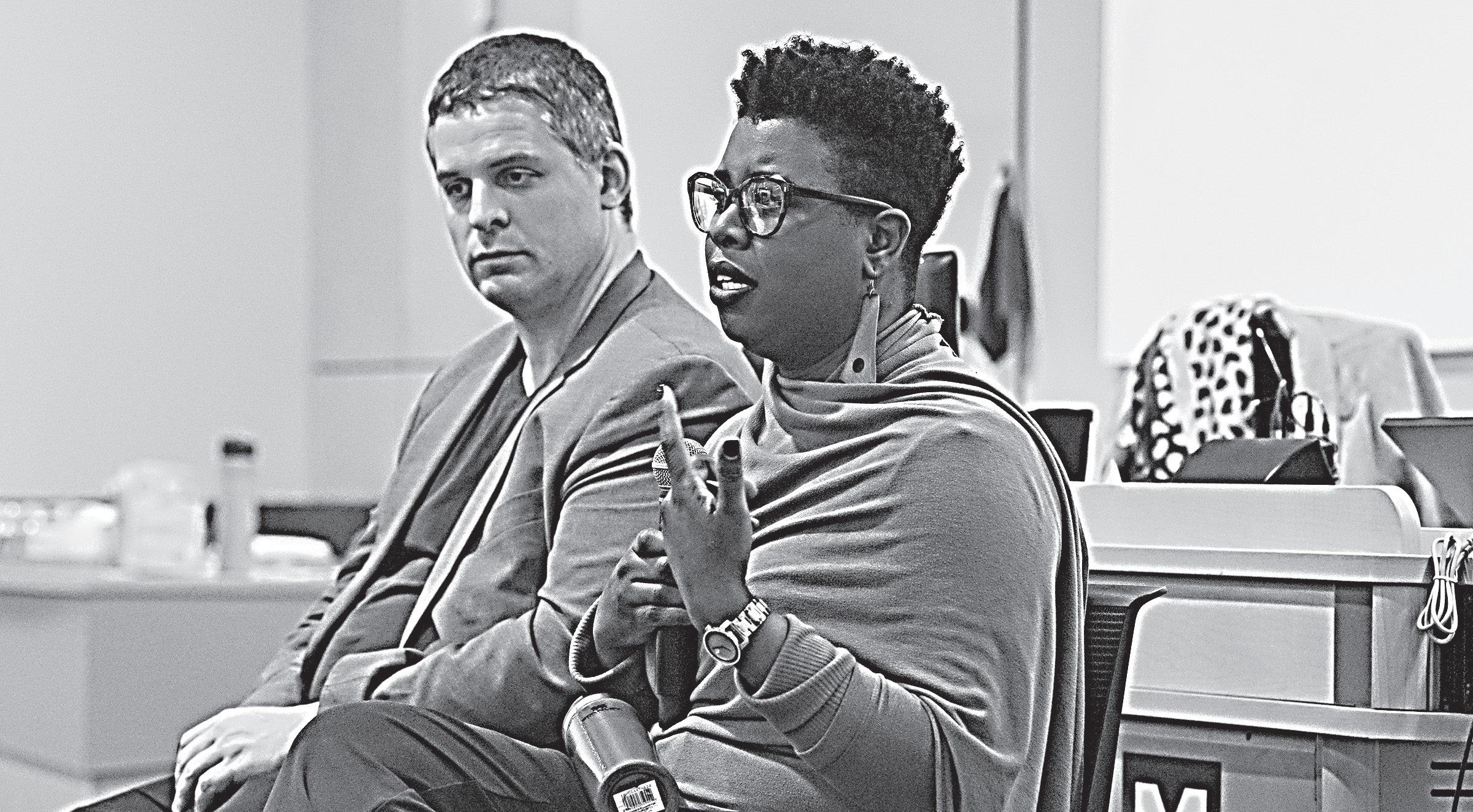
The bill, known as the “Creating a Respectful and Open World for Natural Hair,” or CROWN Act, would amend the existing Act’s
racial protections by banning discrimination based on certain hair styles and textures historically associated with race. The bill would protect hairstyles including, but not limited to, “braids, locks, and twists.”
The bill marks the third time the CROWN Act has been introduced in the Michigan state legislature after the bill failed to make it out of the Republican-controlled House Operations Committee in 2019 and 2021. “(Hair discrimination) is one of the most pressing issues that I hear about, particularly for our Black women,” Anthony told WKAR News earlier this month. “(This includes) folks who have experienced real discrimination, not received promotions on their jobs, not been able to take school pictures in elementary schools, not been given health care services based on how they wear their hair.”
If passed, Michigan would join over a dozen states in ensuring protections against hair discrimination. Though the U.S. House of Representatives passed a federal version of the CROWN Act in March with bipartisan support, the bill was unsuccessful in passing
the U.S. Senate.
The Michigan bill was referred to the Committee on Civil Rights, Judiciary and Public Safety for further review.
2. Updated school emergency procedures
Status: Introduced in the House Introduced on Feb. 14 by state Rep. Kathy Schmaltz, R-Jackson, H.B. 4088 would amend Michigan’s school code to implement recommendations from a bipartisan legislative task force formed after the November 2021 Oxford High School shooting.
The bill proposes the formation of a school-crisis team at all public K-12 institutions in Michigan which would “rapidly address” school safety concerns and require all parents be notified every time the crisis team convene.
The bill was introduced just one day after a mass shooting at Michigan State University left three students dead and five others critically injured. In a statement, Schmaltz said she felt the timing of the bill’s introduction represented the urgency of passing legislation to protect students. “The horrifying events that
unfolded at Michigan State University once again shattered our sense of security and left people across our state with a feeling of deep despair,” Schmaltz said. “In the days following the Oxford tragedy and again today we ask ourselves ‘How could this happen?’ It’s a complex issue with no one simple solution, but the bipartisan bills we introduced represent a willingness to work together to improve school safety and address the mental health needs of Michigan students.”
The bill was referred to the Committee on Education for further review.
3. Personal finance requirement in public schools
Status: Introduced in the House H.B. 4057 was introduced by state Rep. Lori Stone, D-Warren, at the beginning of the month and would enable K-12 students to obtain their required economics credit through completion of the personal finance requirement. The introduction of the bill comes after Whitmer signed a law in June that requiring all K-12 students to take a personal finance class prior to graduation.
Read more at MichiganDaily.com
DEVEN PARIKH and SAFURA SYED Michigan in Color Editors michiganincolor@michigandaily.com
Senior Michigan in Color Editors: Anchal Malh, Udoka Nwansi, Maya Kogulan, Claire Gallagher, Sarah Oguntomilade
CHRISTOPHER BROWN Managing Podcast Editor podeditors@michigandaily.com
Senior Podcast Editor: Martha Starkel
MARTINA ZACKER and CHRISTIAN JULIANO Managing Audience Engagement Editors socialmedia@michigandaily.com
Senior Audience Engagement Editors: Avery Crystal, Matthew Eggers, Aishani Moradia, Tina Yu, Cristina Costin, Steven Tukel, Parvathi Nagappala, Emma Lefevre, Joey Goodsir, Cole Martin
AKSHARA KOOTTALA Chair of Culture, Training, and Inclusion accessandinclusion@michigandaily.com
Business Staff
IRENE CHUNG Creative Director
RILEY SULLIVAN Sales Manager
2 — Wednesday, March 8, 2023 News
RESEARCH 5 bills
The Daily’s
Every month, the Daily tracks important bills on the Congress floor. Here’s 5 from February: GOVERNMENT PHOTO OF THE WEEK The Michigan Daily — michigandaily.com GEORGE WEYKAMP Daily Staff Reporter NADIA TAECKENS & JINGQI ZHU Daily Staff Reporters ASHLEY GRAY/Daily Washtenaw Prosecutors, Eli Savin and Victoria Burton, present at the “Students 4 Decarceration” Speaker Series in the CCCB. The Michigan Daily (ISSN 0745-967) is publishing weekly on Wednesdays for the Winter 2023 semester by students at the University of Michigan. One copy is available free of charge to all readers. Additional copies may be picked up at the Daily’s office for $2. If you would like a current copy of the paper mailed to you, please visit store. pub.umich.edu/michigan-daily-buy-this-edition to place your order.
to watch in the Michigan legislature
research beat visited the Homelab, a lab space that looks like an apartment
#ALIYAHCORE: Digital lookbook come to life

Earmuffs. Belts. Moon Boots. Ripped tights (on one leg, on both arms). And we can’t forget the fur.
Mix these up and we get the freshly risen star of 2023: Aliyah Bah of @ aliyahsinterlude1 fame. And by fame, I do mean it: With 2.5 million followers and 177.6 million likes on TikTok, Bah’s influence is far-reaching. I first found out about her style not by name but by memorable serve — TikTok after TikTok commenting on her polarizing pairing of a bikini with winter boots when vacationing in Jamaica was more than a blip on my radar, but it soon left my scope completely.
In a serendipitous turn of events, it was on New Year’s Eve that the TikTok algorithm placed one of her more recent videos on my For You page. In the video, Bah wore boots and a bikini, both covered in plush charms (like a modern take on the plush pants worn by Flea of the Red Hot Chili Peppers), and excitedly told her detractors to prepare to be “sick of her in 2023”: the self-declared “Year of Aliyahcore.” That was the first time I heard the name Aliyah and, as her timely prognostication indicated, it would be the first of many.
Aliyah and co(re) popped up on my feed often after that. The “-core” suffix is the online way of denoting an object as having a similar vibe or differentia to others. “Cottagecore” is picnic-y, foliage-heavy and rural, like stepping off a page from “Anne of Green Gables,” while “dreamcore” centers on surreal, fuzzy imagery that often wanders into nightmarish territory. As a rule of thumb, anything you would put on a word cloud for the word preceding “core” is fair game. But, with Bah’s first name being that prefix, how can “core” be extrapolated from the spirit of a person?
Thankfully, the Aliyahcore portmanteau would not remain a mystery for long — on Jan.
6 this year, she published a now-pinned video explaining her vision. Bah has implied her style has roots in Y2K and alternative fashion through the self descriptions of “It girl” and “Alt. Girl” present in the Aliyahcore promotional poster. The former style takes its name from the digital scare at the turn of the century — the panic that computers would be unable to comprehend the year ’00 coming after ’99 — but really only refers to the fashion of the ensuing decade. Alternative fashion, on the other hand, is a broader term, vaguely alluding to edgy stylistic nonconformity based on the indie-ification of fashion. With 15 and 39 billion views respectively, these trends have garnered popularity on TikTok, yet due to their unconventional origins, can often be hard to shop for. This is why Bah’s spin on fashion surprised me: there was an unexpected punkness in her argument for accessibility.
While the use of cut fishnets as grungy sleeves is nothing new, she said her “infamous garter,” with its supposed renown indicating exclusivity, could be made with “any cut-up piece of fabric, just (tied) around your leg,” which reminded me of the crafty origins of the punk scene.
A repeated theme throughout the brief video is the feeling of inclusivity. She starts the video by saying styling Aliyahcore is “really not that hard” which is why she wants to share it with us. The video ends by saying the style has “little to do with what you’re wearing but how you accessorize it.”
Although her fashion remains consistent throughout, she will frequently comment praises on fans’ outfits that tag her and her style regardless of how close they come to her vision. Going through the hashtag on TikTok, I find recreations borrowing her style directly, warmer takes that use her as reference and masculine adaptations that subvert the hyperfeminine aspects of her character. Regardless of its content, it is almost certain that when a video tagging her
account appears on my feed, the first comment I will see below it is from Bah. While this could be construed as a continued attempt to solidify her brand, her insistence on maintaining its inclusivity and infectious positivity makes Aliyahcore a label I like to follow.
Unlike other fashion influencers, who I can often only talk about after a lengthy description of their style followed by a failed Google search of “cockroach outfit tiktok bug blazer help” and subsequent dropping of the conversation, Bah’s name is always on my mind. From the constant watermark blazing “#aliyahcore” in her TikToks to the verbal repetition of the term, she continues to ensure her personal style’s relevance and therefore her own.
Bah’s online persona has become a digital lookbook. When I wear pink earmuffs and a white tennis skirt, I conflate the choice with her being instead of her style. I embody a person’s vision instead of
a cultural trend every time I step out wearing pumps with a cute crop top. I become more jovial, unexpectedly bubbly and keep cycling through stock poses on her instagram carrousels instead of my usual ideal animations with renewed confidence directly taken from her person. Consequently, when I struggle with a 10-minute walk due to an outfit’s impracticality, I chastise my own weakness; because Bah conquers the improbable (weather) in campy attire, I know that through Aliyahcore, all things are possible. This entanglement of personhood and brand creates a slight mirage; it’s no longer the influencer’s style, but the influencer herself that becomes a style. Her videos seem to be shot while she’s out and about: at the supermarket, by a wall of graffiti or at the arcade. However, these places are not coded as set pieces but as slices of her life — she’s repeatedly mentioned how
she doesn’t need an occasion and whatever she wears is “everyday attire.” Because of this, Bah is often criticized for wearing impractical airy attire while filming in winter.
However, in the comments of a video, she responded “i dnt be outside for tht long tbh,” indicating it is a nonissue despite her saying her outfits are day-to-day wear. Although I assumed she also dressed in casual clothes, her persona implies that Aliyahcore exists at all times — and through online preservation, she can in fact exist “today, tomorrow, and the day after that.”
However, hearing her digital self actually confirm my belief that Aliyahcore is in a way a performance, going against her paramount tenant of permanence, somehow shocked me. The shock didn’t come from the ‘reveal,’ but the dissonance: after firmly insisting it is the other way around, the lifestyle was revealed as dress-up.
This is not a criticism of her person or her brand, but
a commentary on the effects of publicizing a person as a product. Although I always understood that the pictures were posed, lines prepared and videos produced, the minor incongruence that confirmed the distinct person behind the screen reminded me of the situation at hand. Bah is a model, yes but she is not also her clothes — even if she charges them with her own emotional tone and pathos. However, Aliyahcore is all of that: It is the artificially living, breathing embodiment of a style, born from Bah’s content and gaining symbiotic sentience when those influenced recreate it.
Aliyahcore is not only the essence of a look but the essence of a person through performance and presentation. It posits that on the internet, as in the rest of this increasingly postmodern life: One dresses, therefore they are. And, from yesterday to the rest of 2023 and beyond, Aliyah Bah has certainly made sure that she is.
ALLISON WEI Daily Arts Contributor
When I think of how I’d describe the Ross School of Business, a few thoughts come to mind: classroom building, study spot, home of one of the busiest Starbucks on campus (indeed, it’s rumored that the Business School’s Starbucks has the highest revenue per square foot ratio of all Starbucks in America). An art museum is not one of them.
And yet, step inside the Business School and you’ll find art displays of all kinds, from paintings jutting in front of bathroom doors to sculptures standing in the middle of study spaces. Indeed, the Business School has an impressive art collection of more than 250 contemporary works ranging including sculptures, paintings and photographs, each archived with its own description. Most pieces are gifts from Business alumni, but some were specially commissioned for the Business School. And the collection is growing — in the past year, I have noticed that the Business School has made substantial new additions, silently adding everything from a touching series of black and white photos of construction workers to a gallery wall of lips — all without explanation. The idea that the Business School, in some sense, possesses a secret art museum may have some rolling their eyes, chalking it up to just another ostentatious display of elitism.
I mean, seriously, how much funding does this building get?
And yet, over the years, I have grown a fond appreciation for the art collection at the
Business School, however random or unexplained it may be. Encountering art is always something precious, but in our daily lives, the places where we physically encounter new art not chosen by us are few and far between. I say this not to diminish the value of digital or online art. Through the internet, most of us view some sort of art on a daily basis, whether that’s scrolling through VSCO feeds or making your own curated mood board laptop background. Social media and digital platforms like Youtube and Pinterest have given us access to a broader range of art by more artists than ever. But even this is filtered through algorithms, tailored around our own preferences and search queries.
While there’s nothing wrong with viewing art you like or that’s personalized to your tastes, there’s something to be said about being put in spaces to view art you would never choose for yourself, to see something new — something unexpectedly delightful or surprisingly disturbing, for that is where we grow. Besides Art & Design design, we have a tendency to compartmentalize the times we experience art to special occasions, like a weekend trip to the theater or a new exhibit at the art gallery (this is all assuming that we are interested in visual art and intentionally consume and seek it out on its own).
For this reason, I am grateful as a second-year Business student that the art collection at the Business School superimposes art onto my daily life in ways I can’t resist.
day, I stepped out
my water bottle, mind swirling with stressors (you have a meeting after this, don’t forget the homework in this class, stop by Walgreens today) when I was confronted with this series of images in front of the water fountain.
Looking at these images, I felt something in me unfurl, as if I was letting go of a breath I didn’t know I was holding. Words like “always remember to not let it get too heavy” and “I can feel it all leave your body, yes, let it all go away” deeply resonated, providing a muchneeded reminder of what really mattered. No matter what I did or didn’t get done, there was still compassion and care waiting for me.
To this day, that water bottle filling station is my favorite in the Business School. There’s something poetic about such an intentional placement of the art prints — this idea that as you seek out water for physical refreshment, you might also be mentally refreshed, prompted to surrender whatever worries you may be holding onto.
In this way, art speaks to life. Or rather, this interplay of art and life creates a unique viewing experience. This daily viewing at the Business School is a completely different experience than if you viewed the same series of images in a traditional art gallery.
Viewing art in the context of our daily routines reminds me of an instance Bell Hooks describes in her book, “All About Love: New Visions.”
In the aftermath of a painful breakup, Hooks writes about seeing a street mural during her morning commute that read, “The search for love continues even in the face of great odds.”
This one piece of art gave her a tangible affirmation of hope. From then on, seeing this street mural every day became a lifeline for Hooks, an anchor, a quotidian memorial where she could remind herself, “Yes, there is love. And here is a visual declaration of that truth even when I may not see or believe it.” Hooks’s experience shows us that art is not just peripheral to life, but is vital to its fulfillment. We need art, especially in places like the Business School where life can so easily become consumed by busyness, by the endless cycle of production or consumption. We need art to force us to pause, to behold beauty, to unsettle us, to make us question who we are and why we’re doing what we’re doing.
This weekend, I set out to experience the Business School like never before. Not as a classroom building, study spot or meeting place, but as an art museum. On a Friday afternoon, I took the better portion of an hour to explore the Business School’s art collection and see what I could find. Here are three of my favorite pieces:
#1) “Ross School Construction Workers” by Andy Sachs
“Ross School Construction Workers” by Andy Sachs. Photo by Allison Wei
A stone’s throw away from Starbucks, this series of photographs hangs atop a row of hightop tables and barstools. I study here a lot, especially since the tables can so easily be used as standing desks. When I look up from whatever work I’m doing — whether that’s taking a virtual meeting, checking
emails or working problem sets
— I often find myself eye-to-eye with a person in a hard hat, one of the construction workers who helped build the new Business School building, completed in 2018. Whenever I do this, I find that something in me slows, even softens. Looking at these faces, I’m reminded of why I study what I study: Business, at the end of the day, isn’t just about the money, but about people — creating meaningful work and products/experiences for the communities around me.
I’m also reminded of all I have to be grateful for, all the people I have to thank, including the Business School construction workers, for how I’m able to currently sit in the Business School and do what I’m doing.
#2) “15 Mouths” by Lora Simpson
When I first saw this fiveby-three wall of lips, I burst out laughing. It’s so unexpected. There is something so audacious about these photos, especially in a place as buttoned up as the Business School — where we’re taught professionalism in all situations. Under each photo of lips are words including “fluid,” “meaty” and “sumptuous.” The fact that these words, as sensual and provocative as they are, can coexist with my business communications class right around the corner reminds me of the wonderful plurality in art and in life. Rather than conforming to the space around it, art often subverts the prevailing narrative, shirking norms. In this way, “15 Mouths” is an act of resistance, a redefinition of the space it inhabits.
#3) “Reluctant Hero” by John Schwarz “Reluctant Hero” by John
Schwarz.
a
your
Indeed, there’s something humorous about it, “comical” as its accompanying plaque notes. Made out of recycled materials, the sculpture that resembles a winged robot was given to the school by former Dean Robert J. Dolan (2001-2012). Dolan gifted this sculpture with the intention that it could “inject some whimsy into our sometimes overly serious pursuits.” Ross can so often be an intimidating space — both in the crowds of suited business people and its hard-to-navigate halls — but when I look at the “Reluctant Hero,” I am reminded of the whimsy that lies in all of us.
Just as the “Reluctant Hero” brings child-like whimsy into a space you wouldn’t expect, I’m reminded that we too must learn to continually bring our whimsies and creativities into our daily spaces, meeting our brutal, boring realities with an unwavering spirit.
During my “art museum” tour of the Business School, one of the plaques I read mentioned, “taking a familiar object and lifting it into art by causing us to see mundane moments in a brand new way.” The idea that what we often take as mundane and routine can be transformed into something otherwise stirs hope inside me. In the same way, making space to behold art in all our mundane, daily moments transforms us: making ourselves into something beautiful, something unfamiliar, something altogether new.
The
of
strategy
other
my
lecture to refill
“Ross School Construction Workers” by Andy Sachs. Photo by Allison Wei
Photo by Allison Wei “Reluctant Hero” by John Schwarz. Photo by Allison Wei Located on the second floor of the Business School, it’s hard for this sculpture not to bring
smile to
face.
Arts The Michigan Daily — michigandaily.com
CECILIA LEDEZMA Daily Arts Contributor
Ross’s secret art museum might be my favorite thing about the building
Wednesday, March 8, 2023 — 3
Courtesy of Cecilia Ledezma
Samantha Shannon returns with another fantasy monolith, A Day of Fallen Night’
 LILLIAN PEARCE Daily Arts Writer
LILLIAN PEARCE Daily Arts Writer
Over the summer, my friend and I started a bookclub to tackle our individual to-be-read piles. One of their picks was “The Priory of the Orange Tree,” an 800-page fantasy that had been trending on BookTok for several months. As a rare reader of fantasy and 800-page books alike, I was apprehensive about their choice; however, after making them read Joan Didion’s “Slouching Towards Bethlehem” (which left both of us disappointed and bored), I owed them. We began “Priory of the Orange Tree” in May, and finished it two, long months later.
“The Priory of the Orange Tree” is not a book that can be easily summarized, given that it could be smoothly separated into a trilogy. An evil fire-breathing “wyrm” (different from the peaceful water dragons) known as “The Nameless One” is gaining strength, leaving everyone increasingly terrified of its return after having been defeated 1,000 years ago. Unfortunately, the world is divided based on their religious and wyrm/dragon beliefs, making it impossible for the regions to unite: in the East, people have close relationships with dragons, viewing them as Gods; in the West, also known as The Queendom of Inys, wyrms and dragons alike are feared and Queen Sabran IX rules as the direct descendant of the original slayer of The Nameless One, Sir Galian; and in the South resides the “secret mage society of The Priory,” which believes the original slayer was not Sir Galian, but rather his wife, Princess Cleolind, and if I am remembering correctly, understand the difference between evil fire wyrms and good water dragons.
In addition to those conflicting politics, there’s a draconic plague,
forbidden romances, a wellexecuted lesbian relationship and magical fruit. To say there’s a lot going on is an understatement.
Shannon is nothing short of ambitious, which she proves again with her new release “A Day of Fallen Night,” the prequel to “The Priory of the Orange Tree.” The world is again divided into the aforementioned regions (as well as the North), which Shannon alternates between in each chapter.
Though “A Day of Fallen Night” is another long-strung tale of dragons and magic, Shannon roots the story in three specific characters, all of whom are young women coming of age in their respective part of the world: Dumai in the East, Glorian in the West and Siyu in the South.
Though their paths are diverse — Dumai spends her days serving the great Kwiriki, Glorian prepares to take over the throne and Siyu awaits her ascension into the Priory — the characters mirror each other
in their ambitious and rebellious desires as they navigate their duties to their families, their regions and their realm.
At this point in time, dragons have entered what is referred to as “the long slumber.” Though they can be awakened by the ringing of sacred bells, it is understood that the dragons should not be disturbed unless absolutely necessary. While the dragons sleep, wyrms begin to rise. In each region of the world, boulder-like rocks are found that generate a powerful and unfamiliar heat. Each region suffers the consequences of their arrival and prepares to defend their respective part of the world the best way they know how: in the West, with alliances; in the South, with magic; in the East, with dragons.
Though Shannon incorporates similar themes and storylines in “A Day of Fallen Night,” what sets it apart from “The Priory of
‘Ice Merchants’ traded my ice-cold heart for hats
KRISTEN SU Daily Arts Writer
Calling all corporate higher-ups: Trust falls are no longer the best way for your employees to practice team building. Try freefalls from the top of a mountain, with a child strapped to each of their chests. This technique worked for the characters of writer-director João Gonzalez’s (“Nestor”) animated short “Ice Merchants,” so it should work for you.
one piece of the story at a time. Gonzalez is tasked with both keeping the viewer interested in each individual frame and building towards a bigger purpose later on.
“If

the Orange Tree” is its dynamic characters and their carefully crafted relationships. In each region, the three aforementioned women are heavily influenced by their relationships with their mother: Dumai’s mother, Unora, fled while pregnant with her to the East, where she raised Dumai in seclusion; their strong relationship is later upended by the arrival of Dumai’s father. Glorian’s relationship with her mother, Queen Sabran VI, is quite strenuous. Queen Sabran is incredibly chaste concerning her love for her daughter; when Glorian breaks her arm, for example, she refrains from visiting her. Siyu and her mother, Esbra, have perhaps the most complicated relationship of all — in the Priory, the Mother (Cleolind) is loved and worshipped above all else, and this sacred devotion displaces Esbra’s love for Siyu.
Times Daily Crossword Puzzle


The premise of “Ice Merchants” is inherently ridiculous. A fatherson duo lives on the edge of a mountaintop in a house suspended by pulleys and ropes. The son sits on a swing attached to the house, and every time he propels himself outward, the audience gets a sense of just how high up they are. The house creaks constantly due to the harsh winds and the quite literal suspense kept me on the edge of my seat, waiting for them to plummet.
Every day, in order to sell a single box of ice to the people at the foot of the mountain, they jump from the edge of their front porch, trusting a parachute to break their fall. During the jump, their hats fall off, and to make up for it, they buy new, identical ones from a hat shop at the foot of the mountain. Each night, they come home and share a quiet meal together.
Despite the contentment that the father and son seem to have with their lives, there’s a subtle, underlying grief due to the semirecent passing of the son’s mother. The first indication of this isn’t until a few minutes into the film, when a kitchen cupboard is opened and there are three mugs. Her story is also deeply intertwined with theirs.
It’s easy to suspend disbelief when the cinematography is marvelous. In fact, the seamless transition between different shots is enough on its own for this short to win the Oscar. When the father and son are freefalling, the camera moves as if the audience is as well, enlarging body parts at random, sweeping upward to give the illusion of flying, suddenly moving back downward when he pulls the parachute cord. Similar shapes blend into one another as a way to transition between scenes, the roundness of the bottom of a thermometer attached to their front door mirroring the sun. There is no dialogue, so every shot is intentional, revealing
The animation initially looked more like a sketch than a wellimagined series of paintings. The mountaintops in the first scene are unevenly filled in and the wobbly outlines of objects such as the house make some of the background seem messier than computer-animated films. I was afraid that the scenery would look too simplistic and empty, thereby making it harder to take in the meaningful storyline that was unfolding.
This was one of the most gorgeous pieces of art I’ve ever seen. The limited color palette consists of warm colors and the darker shades of the mountain. The animation style expertly plays around with shadow in order to heighten the contrast between these colors. In one nighttime scene where the father sits opposite the dinner table from his late wife’s mug, his face and his side of the room is shrouded in shadows, while the mug and the rest of the room is illuminated by the fireplace. When he goes to sleep, he’s dimly lit, while moonlight shines on the empty space next to him in the bed.
After getting used to the scary backdrop of living on top of a mountain, there’s a lingering serenity in the father and son’s day to day routines. Piano and strings together make up the soundtrack, which Gonzalez composed himself, bringing excitement to the freefall scenes and morose undertones to the quiet, subdued moments of reflection. The sounds of the swing, the ice box opening, the chipping of ice into smaller cubes, the wind gushing, the ringing bell and the crackling fireplace all stay the same from day to day. For a few minutes, the world stands still, making way for the mundanity of a father and son’s humble existence.
Then, that mundanity breaks and no “I never cry at movies” audience member (I’m talking about myself) is safe from the incessant sobbing that follows. The threat of rising temperatures and increasing emotional tension make it hard for the father-son duo to keep on going. In the end, they can only rely on one another.
Indigo De Souza’s ‘Younger & Dumber’ is devastating though achingly hopeful
CLAIRE SUDOL Music Beat Editor
Different from Indigo De Souza’s usual soundscape, her new single “Younger & Dumber” is gentle and somber in its approach, leaning heavily on atmospheric sounds rather than clamorous drums and gritty guitars. The track opens with reserved piano and guitar moving in sync and then diverging — one line moving upwards, another dipping down before meeting again in the middle. Indigo’s voice parts the dancing melodies. It’s heavy and weary, almost on the verge of breaking, and at moments, you half expect to hear her dissolve into desolation. The strippedback instrumentation heightens the bone-sore, aching delivery of disarming lyricism, offering us a new vantage point from which to observe: “I get so tired of filling the space all around mе / And the love I feel is so powerful it can take you anywhere.”
“The
“Younger & Dumber” teems with the melancholy of nostalgia; it’s about sorrow for a past self, for a childhood, or for a memory.
Crushing, cascading drums rumble in the lower regions of the envelope, building, building, building towards a soaring moment in the chorus where
the track balloons up and swells with a quivering hope. It’s an earth-shattering apex that is both devastating and exultant. Maybe once we were naive and stupid; maybe once we were taken advantage of by someone we loved; but now, in this moment, we are smarter, bigger and stronger than anyone who has ever hurt us. “Younger & Dumber” holds us in a bone-crushing embrace throughout its nearly five-minute play time, leaving us wiser and more sure-footed than ever.
This is a new sonic landscape for Indigo De Souza, whose discography leans into chattering drums and dense bass lines running steadily underneath rough electric guitar. I love that side of Indigo, where she explores the fast-paced and sonically dense, but in the simple act of stripping back, the track opens itself up to listeners, tearing back the soft and squishy parts, exposing a beating heart and the crimson life rushing through it. Listeners are allowed to bear witness to an unfiltered, barefaced reckoning with a past self, an almost love letter, or even a memory. A track as human as this leaves me excited for more, hanging onto her every move with bated breath and eager anticipation.
4 — Wednesday, March 8, 2023 Arts The Michigan Daily — michigandaily.com
Design by Phoebe Unwin
puzzle by sudokusnydictation.com By Beth Rubin & Will Nediger ©2023 Tribune Content Agency, LLC 03/08/23
Angeles
Edited by Patti Varol and Joyce Nichols Lewis 03/08/23 ANSWER TO PREVIOUS PUZZLE: Release Date: Wednesday, March 8, 2023 ACROSS 1 Roughly 5 Skin blemish 9 Poetic contraction 12 Inheritance recipients 14 Slurpee-like drinks 16 Astronaut Jemison 17 Parade with strict precision 19 Body shop fig. 20 __ Lanka 21 Conclusion 22 One providing misguided support 24 Milan opera house 26 Pull up stakes for one’s co. 27 Hint 30 Starbucks size 31 Gains a lap 32 “Stay right there!” 34 Fuel economy meas. 35 Tropical storm 36 More inclusive 40 See red? 41 Sorting factor in some directories 42 Blessing 44 British noble 45 “Saving Private Ryan” event 46 Medical pros 47 Opens, as a gift 49 Sound bite, e.g. 51 Sked info 52 April 15 payment 55 Original Beatle Sutcliffe 56 Metaphor for something that can’t be changed, and what’s found five times in this puzzle? 59 Keystone figure 60 Lofty nest 61 Shrub that may be toxic 62 Informer, maybe 63 Saxophone insert 64 Repair DOWN 1 Electrical units 2 Caboose 3 Virtual assistant on Apple devices 4 Goblinlike fantasy creature 5 South Dakota national park known for its air currents 6 Rm. coolers 7 Share again, as a joke 8 “Ooo La La La” singer __ Marie 9 Brunch dish 10 Stands in a studio 11 Nostalgiainducing 13 “__ Butter Baby”: Ari Lennox/J. Cole song 15 Hydrotherapy spot 18 Not negotiable 23 Bandits 24 Live it up 25 Pub choice 27 Public health agcy. 28 Poet Mina or actress Myrna 29 Chapel Hill sch. 31 Ad 33 Like freshly cut lawns 34 Fred Flintstone’s boss 36 Raced (along) 37 Family man 38 Horvath of “The Rings of Power” 39 Marina del __, California 41 Bar code? 42 Cereal eater’s proof of purchase 43 Keep busy 44 Unabridged 46 Secretaries, e.g. 47 __ Peninsula: Michigan home of Yoopers 48 Cushions 50 Pretoria’s land: Abbr. 52 Umpire’s cry 53 Mathematician Turing 54 Randall Munroe’s webcomic of “romance, sarcasm, math, and language” 57 Two truths and a __: icebreaker game 58 Autumn flower, for short SUDOKU WHISPER
Los
alone.”
you are struggling, you are not
WHISPER By Enrique Henestroza Anguiano ©2023 Tribune Content Agency, LLC 02/15/23 Los Angeles Times Daily Crossword Puzzle Edited by Patti Varol and Joyce Nichols Lewis 02/15/23 PREVIOUS PUZZLE: Release Date: Wednesday, February 15, 2023 ACROSS 1 Tool that can be a musical instrument 4 Not berthed 8 Designated 14 Confidentiality contract: Abbr. 15 Spider-Man co-creator Lee 16 Prophecy source 17 Get-together with a sketchy vibe? 19 Beam benders 20 Cookie-based dessert 21 Spanish “those” 22 Salon job 23 Marketer’s blitz campaign? 28 Affirmative replies 30 General on a menu 31 Sign of healing 32 __ Cruces, New Mexico 34 “Yeah, I guess” 36 Pickleball shot 37 Intercom call on Take Your Child to Work Day? 40 Mud bath spot 42 Bash who co-hosts CNN’s “State of the Union” 43 Mo 44 The Buckeye State 46 WNBA official 47 A few bucks, say 51 Shake Weight and The Flex Belt, per their infomercials? 55 Heaps 56 Limo destination 57 Jack up 59 Nut used to make vegan cheese 62 Cold Hawaiian treat ... or a directive followed four times in this puzzle? 63 Understood by few 64 Despise 65 Org. with seven teams in Canada 66 “This Is Spinal Tap” director 67 Lyft competitor 68 Game Boy batteries DOWN 1 Beagle who pilots an imaginary Sopwith Camel 2 Like premium streaming services 3 Communion rounds 4 Urgent letters 5 Narrow piece 6 Foodie website covering 25 metro areas 7 “__ takers?” 8 Arcade achievements 9 Bad move 10 Ups the ante 11 Telethon VIPs 12 Blight-stricken tree 13 __ Moines 18 Grapefruit kin 21 Succeed 24 “You can come out now” 25 Rights advocacy gp. 26 __ Tomé and Príncipe 27 Recede 29 Hourglass stuff 33 Draw for some pictures 35 Contact lens holders 37 Uttered 38 Hr. for an afterlunch nap, maybe 39 Interval of eight notes 40 Cry noisily 41 Soup with rice noodles 45 Anne of Green Gables, for one 48 “Riverdale” actress Huffman 49 “Caught red-handed!” 50 Braces (oneself) 52 Nobel-winning chemist JoliotCurie 53 Process that may involve PT or OT 54 Roofing option 58 Of all time 59 Subway unit 60 “What __ those?” 61 Bio or chem 62 Moo __ pork Read more at MichiganDaily.com
break was so short.”
at MichiganDaily.com
Read more
The Michigan Daily — michigandaily.com Wednesday, March 8, 2023 — 5
BHM Music Retrospects 2: Tracy Chapman, class consciousness
CEDRIC McCOY MiC Assistant Editor
For Black History Month 2023, I will be publishing a mini-series of short music reviews under the title “Protest Music Retrospects.” The aim of this series is to both revisit some of the most pivotal moments in Black protest music history and to shed light on overlooked Black figures and musics, specifically those of Black women, that have contributed to socially-conscious popular culture. The reviews will be a mix of musical critique as well as historical and historiographical analysis of the works and their responses in media. I first highlighted Sister Souljah’s 360 Degrees of Power ; for this next entry, I will continue the series with Tracy Chapman’s 1988 debut and self-titled album, Tracy Chapman Arguably, Tracy Chapman isn’t exactly “overlooked.” It is one of the best-selling albums of all time (having sold over 20 million copies worldwide and certified platinum six times over) and earned Chapman Grammys for Best Contemporary Folk Album, Best Female Pop Vocal Performance (for “Fast Car”) and Best New Artist. However, I argue that the political themes and lyricism of Tracy Chapman is frequently missed in discussions of protest music of the era; released in the same year as N.W.A.’s Straight Outta Compton and Public Enemy’s It Takes a Nation of Millions to Hold Us Back , the surviving narrative is that Black male rappers and emcees pioneered the new resistance. The intrigue of “Fast Car” quickly became what Tracy Chapman was known for,
and in combination with the fact that she was a Black woman making folk music in the late 20th century, the politicization of her lyrics was lost on a majority of audiences. As a result of her commercial success, contemporary accounts strip Chapman of her evocative and powerful commentary.
Tracy Chapman is, at its core, an album that documents the experience of a working class Black woman. Chapman, in a traditional folk style, often positions herself as a narrator outside of the story actively being told; even so, she weaves her knowledge and experiences into the narrative. For example, in the lead track “Talkin’ Bout a Revolution,” Chapman discusses the rumblings of an impoverished and overexploited working class interested in a “revolution,” wherein “poor people gonna rise up / and take their share / poor people gonna rise up / and take what’s theirs.”

Raised by a working-class family in Cleveland, Chapman knows firsthand the challenges of working-class Americans and is able to dictate the experience with a certain specificity: “While they’re standing in the welfare lines” in the first verse becomes “I’ve been standing in the welfare lines” in the third verse. “Talkin’ Bout a Revolution” sets the tone for an album unmistakably entrenched in the struggle.
Every subsequent track on the album continues this thread of what Southern University professor Dr. Rasheedah Jenkins describes as “unabashed critique of the economic system’s virulence during the Reagan-Bush administration and its global
influence.” In songs like the album’s lead single “Fast Car” and “She’s Got Her Ticket,” Chapman tells stories of women desperately seeking an escape from poverty and lack of opportunity; “Why?” and “Behind the Wall” comment on violence against women, both domestically and globally; “Mountain O’ Things” critiques American materialism and exploitative labor practices and so on. In each track Chapman addresses these issues with nuance and empathy, directly personifying the resistance of capitalist oppressions and state violence.
Even beyond her searing indictments of American society and western greed, there is something unique and admirable about Chapman’s lyrics that I find especially worth noting. In contrast to the hyper-masculine and chauvinistic aggression found in some of her male contemporaries, Chapman centers love and understanding in her narratives. She connects herself to the stories she tells — not to center herself, but to engage the reader in a more personal listening of her lyrics. In “If Not Now…” Chapman spends the first few verses presenting economic and social liberation as the ruling class’s unrequited love for the working class, but then presents this line in the final verse: “Now love’s the only thing that’s free / we must take it where it’s found.” Immediately this could be read as a continuation of her running metaphor, that we should seize opportunity when it finds us; I argue that Chapman intends a second, more literal meaning with the lyric. In the same way that she has humanized the working-class stories through-
BHM music retrospects 3: Elaine Brown, the Black Panther Party and sexism within liberatory politics
For Black History Month 2023, I will be publishing a mini-series of short music reviews under the title “Protest Music Retrospects.” The aim of this series is to both revisit some of the most pivotal moments in Black protest music history and to shed light on overlooked Black figures and musics, specifically those of Black women, that have contributed to socially-conscious popular culture. The reviews will be a mix of musical critique as well as historical and historiographical analysis of the works and their responses in media. I first highlighted Sister Souljah’s 360 Degrees of Power and then Tracy Chapman’s debut album; for the final entry, I will finish the series with Elaine Brown’s 1969 album, Seize the Time Brown is best known for her activism in Black Liberatory politics. She served as the leader of the Black Panther Party after Huey P. Newton fled to Cuba in the mid70s, before leaving the party due to sexist leadership; she was the first and only woman to lead the party, and shifted the standard operations and the philosophies of the BPP towards inclusivity and local advocacy. In addition to her activism, Brown was trained as a musician from an early age and wrote poetry and songs in high school. In 1968, David Hilliard, then-BPP chief of staff commissioned Brown to record some of her politicized songs for the BPP after he heard her perform for some other Panthers — Seize The Time was the result.
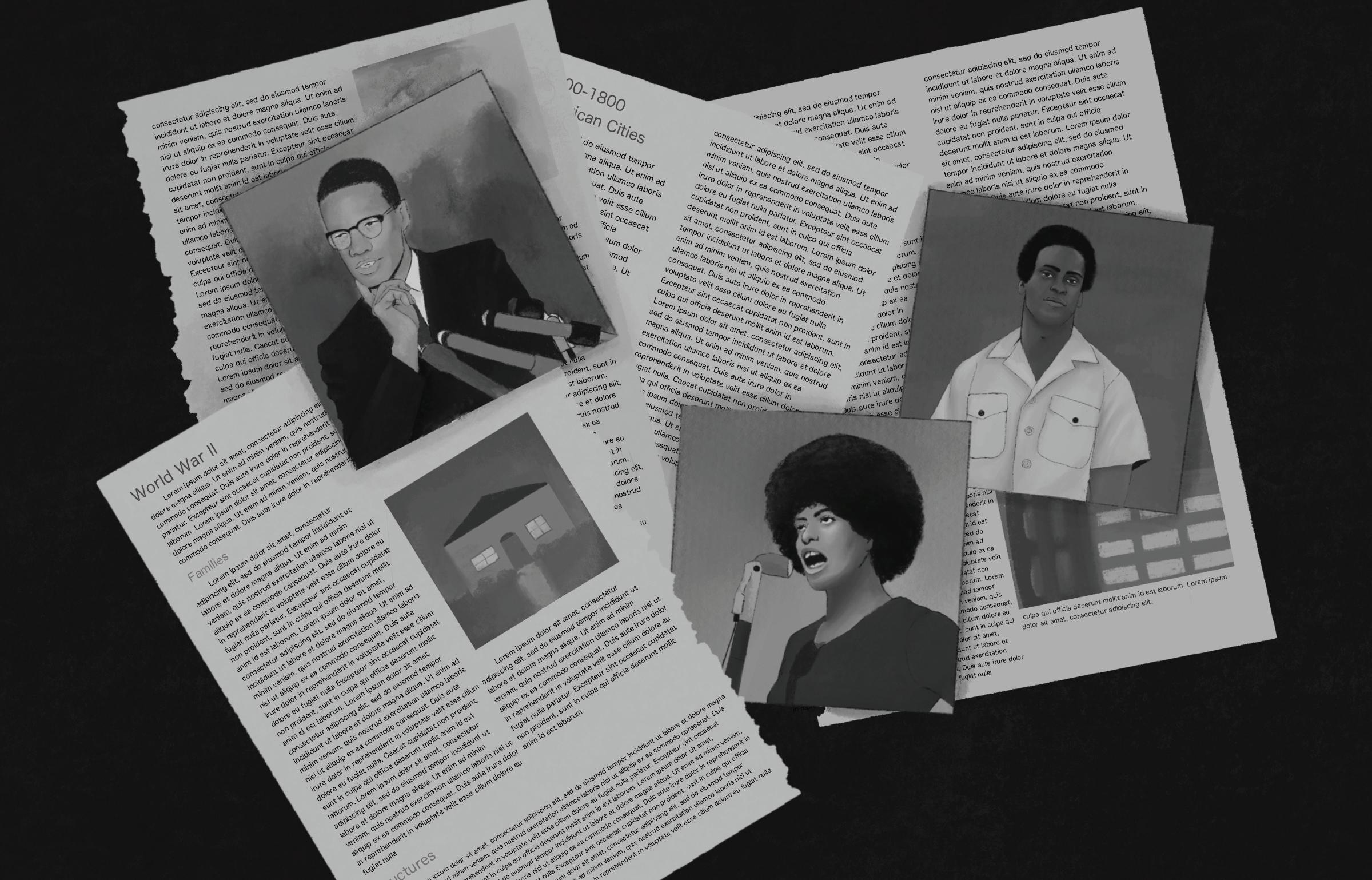
Seize The Time exists as a recording (in more ways than one) of the motivations, goals and activism of the BPP. The album contains the party’s unofficial theme, “The Meeting,” as well as various other revolutionary tracks that were often played at BPP social events. Additionally, its cover art was created by Emory Douglas, BPP Minister of Culture. While it is not the only output of music from the BPP (the party also had a funk band composed of active members called “The Lumpen”), it is the only audio album produced by the party that featured exclusively music.
Brown’s Seize The Time is largely unrecognized by scholars
and music fans alike; in researching the album for this article, I only found one comprehensive record of it by Michael Lupo of Répertoire International de Littérature Musicale on Smithsonian.
From my knowledge of public history projects documenting music of the era, only PBS’s Fight the Power seems to have recognized it (and only in a passing montage of relevant albums). There is no official set of transcribed lyrics either; the original record did not include any with it, and opensource databases like Genius have not tackled the 10 tracks. Fortunately, the album (and its remaster) are available on the major streaming platforms and have not been lost to time just yet.
When I first envisioned this BHM mini-series, Seize The Time was the album I had in mind and most desired to write about. It represents a key shift in the canon of Black protest music in many ways. First, the songs are all composed and performed by a Black woman, one who was often ostracized by her fellow revolutionaries. Second, it predates the move towards overtly political music found in the `70s. Lastly, it demonstrates a unique application of protest music wherein the music serves in a direct-action/political praxis role, beyond “calls to action” or indictments.
Brown was classically trained in both music and dance in her youth, producing a certain restricted philosophy of praxis demonstrated in Seize The Time Her music leans away from the powerful and raucous funk and soul of the `60s in favor of a more refined, authoritative tone. Though some of her contemporaries resisted this style, higher-ups in the party (namely Huey P. Newton) were fans of her music and supported her songwriting. The arrangements and orchestration were done by Horace Tapscott, pianist and jazz band leader, further solidifying the sound of Brown’s music into existing tradition.
Despite her western-influenced training, the lyricism of Seize The Time consists of a wide range of critiques. In the tracks, Brown addresses systemic racism and oppression, but also engages with the often violent, male aesthetic of the BPP. In “The End of Silence,” Brown includes these lines:
out the album, Chapman humanizes our fundamental desire to be acknowledged and cared for. I feel that the album’s final track, “For You,” can also be understood in this double-meaning framework.
Essentially, I encourage the reader to see Chapman’s debut album through a womanist lens – especially regarding the second definition ascribed to the term by its originator, Alice Walker:
“A woman who loves other women, sexually and/or nonsexually. Appreciates and prefers women’s culture, women’s emotional flexibility (values tears as natural counterbalance of laughter), and women’s strength. Sometimes loves individual men, sexually and/ or nonsexually. Committed to survival and wholeness of entire people, male and female.”
While Chapman has never publicly disclosed information about her sexual preferences or identity, we do know that there is potential to see her life and work through a queer lens (ironically, as a result of Alice Walker herself disclosing her and Chapman’s affairs). I borrow musicologist Suzanne Cusick’s framework for understanding music through a lesbian lens from her article “On A Lesbian Relationship with Music” to extend this analysis. Cusick argues that a (assumedly oversimplified but fundamental in nature) lesbian relationship lacks the traditionally heterosexual power dynamic: (A woman) is non-power: to be in love with her is to be in love with, to be fascinated by, to be drawn to that which is non-power. With her, a self who is also non-power is more likely to create a relationship based on non-power…No one in the relationship has been formed to be
the power figure, although all can play at it.
In short, Cusick claims that queer relationships (but that specifically of lesbians) defy a hierarchical, vertical power structure in favor of a horizontal, fluid power structure. I find this lens, applied to music specifically as Cusick later does, useful in understanding Chapman’s work because it lacks that exact power dynamic protest music had come to embody in that moment: in contrast to a prophet or speaker for Black America to rally behind and listen to, Chapman simply tells her story as-is and lends her ear to her working-class comrades. Chapman, in the face of multiple jeopardy systemic oppressions, advocates intracommunal love and the liberation of all through mutual efforts. There is no appeal
Courtesy of Elektra Records
to violence or physical rage, as such devices are unnecessary in her approach; rather, it is more useful to understand one another and build solidarity in absence of hierarchical power structures, both in terms of race and gender but as well as sexuality.
Tracy Chapman will be remembered by, as it already is, Chapman’s transparent and relatable lyricism as well as her politically informed criticisms. In addition to the genre-defining musicality and emotion displayed throughout Chapman’s recordings, I hope that the album is revered for its revolutionary draw to love and its commitment to radical empathy within the canon of Black protest music for generations to come. The album is potent with themes, analysis and lyrics to pick apart for at least a few more decades.
Finding
And you can’t go on
With this time-worn song
That just won’t change the way you feel
Well then, believe it my friend
That this silence will end
We’ll just have to get guns
And be men
Though Brown was known for her ardent anti-sexism stance with the BPP (which often abused and overworked her and other women despite their majority and important contributions), the gendered language of her music leaves much to be desired. See also this excerpt from “The Panther,” which aimed to paint the BPP in a strong, revolutionary light: “He is a hero, he walks with night / His spirit’s beauty, his soul is right … His face is black and he would die for you / To get your freedom back.”
I find that contextualizing Brown’s classical training as well as her high ranking in the party is central in understanding her portrayal of the Black revolutionary. History has often looked upon resistances through the lens of individuals, such as that of Great Man Theory; even today, names like Newton, Bobby Seale, Fred Hampton, Eldridge Cleaver and those of other Black men are used almost metonymically to reference the Black Power movement of the era. Brown met the BPP where it was, both politically and musically, but consistently challenged the party and its leaders to do better and to approach the Black experience with more intersectionality than its founders had originally intended.
Brown’s leadership in the party, and also her musical contributions to the soundscape of Black liberatory politics are key components in the construction of an accurate and holistic narrative of the BPP and protest music. Though Seize The Time never received airplay, charted or earned Brown much compensation, her work as a musician has recently begun to be recognized for its impact on her contemporaries as well as Black protest music as a whole. Records of her activism now often mention her musicianship alongside her politics. Beyond her direct successors, artists such as Alicia Keys have also memorialized her impact on Black music.
The moment I stared down the barrel of a gun, I realized that the society I was born into would rather have me dead than oppose its oppressive existence.
A ghost. An inescapable prison. A stranger in an alltoo-familiar land. There are too many analogies to describe the lived experience of growing up a Black man in the suburban Deep South. The themes that unite them all, though, are the isolation, the danger, the violence and the grieving for the home that never was. In that land, my presence felt like a stain on the sterile landscape of endless highways, strip malls and picket-fenced homes. Children go to school in East Cobb and learn from textbooks that never tell my story.
Maybe that’s why I’m so obsessed with history. In my youth, I poured over maps, atlases and history books trying to figure out where I fit into the narrative. Racism was taught as a past era, yet I lived with slurs carved into my lunch table. Protectors of slavery were depicted as heroes and etched into statues and carvings on the sides of the mountains that loomed over the land. I knew the pages that told my story were missing; I just had
to find them.
It turns out I didn’t have to search any further than my own family’s past. My father kept a secret that I knew held answers to questions I didn’t even know to ask. In an attempt to assimilate, to live, to provide for his family, he kept his upbringing a closely guarded secret. My father’s name is Akil Karim, but he prefers to be called “Ace.” All of my dad’s siblings were given religious Arabic names at birth, while only a generation later, I was given the name of a Christian saint. My only connection to the language that held such significance to my grandparents was when it was demonized in the church I grew up in, taught to me as “the language of the blasphemous.”
All the secrecy dissipated when my grandmother passed. At her memorial, I learned that she was a revolutionary– both my grandparents were. My grandmother was Malcolm X’s secretary, and my grandfather was a farmer. They were Muslim Black nationalists. Fleeing the sea of police-registered bullets that engulfed the crowded streets of Philadelphia, they left on an Exodus to unfamiliar land. They converted to Islam, started a farm in New Jersey and raised a family. Whether it be creating networks of mutual aid or organizing within revolutionary vanguards, their
https://mail.google.com/mail/ u/0?ui=2&ik=7c5dd0c6e9&atti d=0.1&permmsgid=msg-f:1759 751793368182118&th=186be4ee b8912d66&view=att&disp=saf e&realattid=f_leyuu7bt0 commitment never wavered from their community, and they did whatever they could to serve it.
For the first time in my life, I had discovered a page of my history. That one page opened the floodgates for me to discover the history of my people, what we stand for and who we really are. I am born to a people burned by the hot southern sun, one that continues to brand me as a foreigner to this land. The sweat and tears of generations of revolutionaries who fought for collective liberation have hardened into indestructible armor that covers my body. I am born to a people with two hearts, one that weeps for the home it was stolen from and one that weeps for the one it inhabits.
Through finding my history, I found my ancestors and the lessons they had for me. Frantz Fanon and Amílcar Cabral, two fathers of anticolonial revolution, taught me what it meant to not just be Black but be African. Angela Davis, the Black communist who refused to be silenced in the face of the carceral state, taught me the
Michigan in Color 6 — Wednesday, March 8, 2023
The Michigan Daily — michigandaily.com
The pages that tell my story:
purpose, community and a sense of self as a Black man in the U.S.
CEDRIC McCOY MiC Assistant Editor
Read more at MichiganDaily.com
JOSEPH FISHER MiC Columnist
Design by Abby Schreck
at
Read more
MichiganDaily.com
The Sunday morning of Sept. 15, 1963 was Youth Day at the 16th Street Baptist Church in Birmingham, Ala. Dr. Sarah Collins Rudolph described it as a joyous morning buzzing with excitement and children’s laughter as she and four other little girls went to the basement of the church to freshen up. These four little girls were her sister, Addie Mae Collins, and best friends Denise McNair, Carole Robertson and Cynthia Wesley. While down in that basement of a place that was meant to be safe and sacred, Rudolph recalls hearing a “big BOOM.” She called out for her sister Addie Mae again and again to no response, then everything went black.
It was only days later while recovering in the hospital, now blind in her left eye, that Rudolph was informed that she was carried out of that basement through the hole left by the bomb by a bishop as the only survivor. The lives of her sister Addie Mae and friends Denise, Carole and Cynthia were taken that day due to a hateful attack by four members of the Ku Klux Klan. The city of Birmingham, Ala. was forever
An evening for Sarah
changed as a resurgence of protests and strikes broke out.
This was the scene portrayed in a powerful dance performed by “Music, Theatre & Dance senior Brooke Taylor and members of the Black Scholars in Dance organization titled “For the Five.”
Audience members were frozen in their seats as Music, Theatre & Dance sophomore Nile Andah provided vocals, accompanied by LSA senior Favour Kerobo on the piano, began to sing “Pass me not, O gentle Savior / Hear my humble cry / While on others Thou art calling / Do not pass me by” and the five women on stage danced the sentiments of that horrid day in Birmingham, Ala.
The mood of the piece continuously shifted from childlike joy and innocence to sorrow and loss. Taylor, at various points, seemed to lose herself in the playfulness of each girl’s dance, whether that be through laughter or skipping or swinging hand in hand until she was dragged back into the harsh reality of what had happened and the tears on stage were more than real.
The final scene of this performance still holds residence in my mind. Four dancers all dressed in white (representing the four girls that were murdered) wave goodbye to Taylor, who was representing Sarah Collins Rudolph, as the chorus of the hymn “Pass

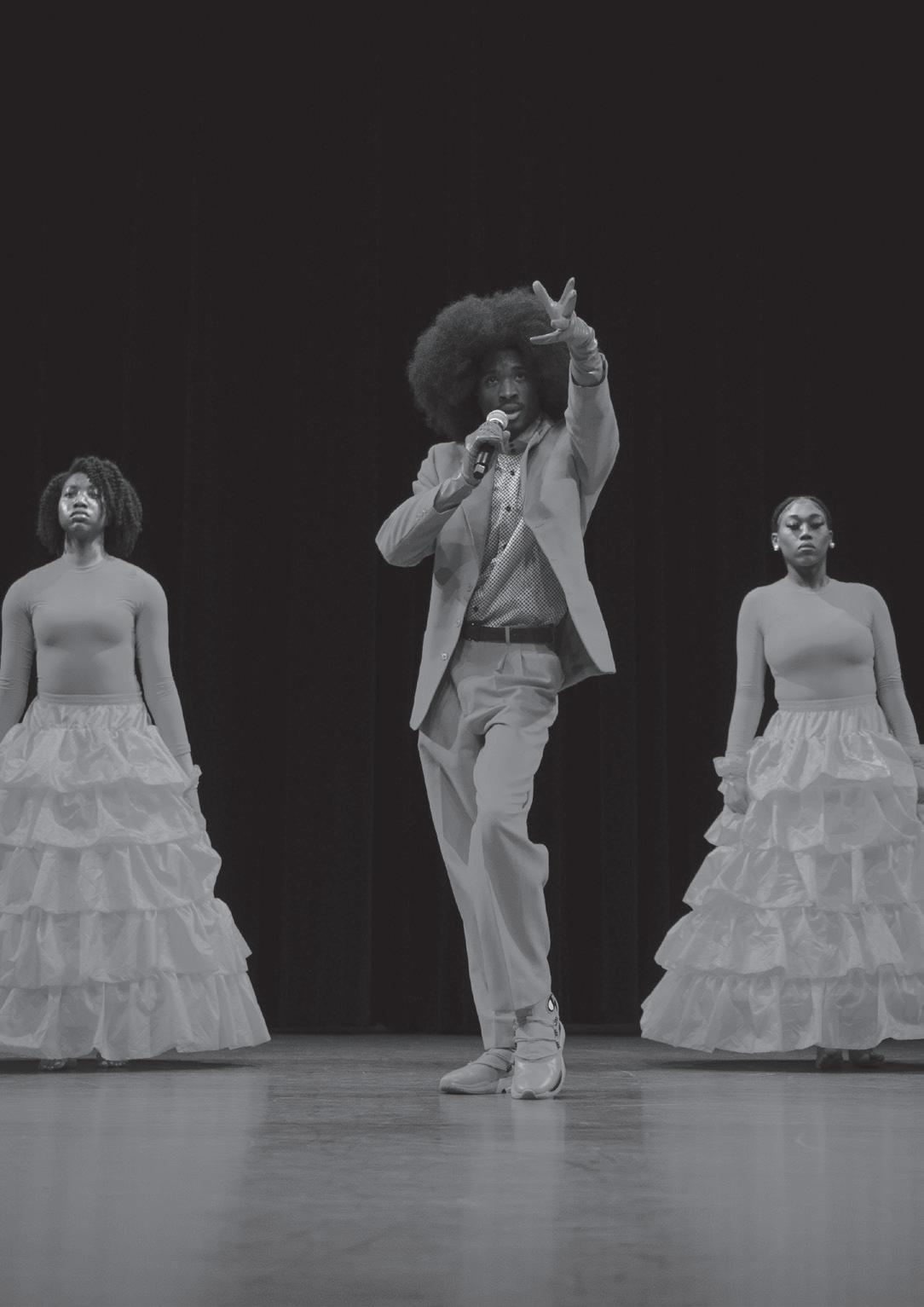
Me Not, O Gentle Savior” bellows over the room. As the lights cut out at the end of the number, the room is silent except for sounds of sniffling. Even backstage, where I was located, the other performers could not help themselves from crying.
The final scene of this performance still holds residence in my mind. Four dancers all dressed in white (representing the four girls that were murdered) wave goodbye to Taylor, who was representing Sarah Collins Rudolph, as the chorus of the hymn “Pass Me Not, O Gentle Savior” bellows over the room. As the lights cut out at the end of the number, the room is silent except for sounds of sniffling. Even backstage, where I was located, the other performers could not help themselves from crying.
Thus, “An Evening for Sarah: A concert in honor of the civil rights activist and survivor of the 16th Street Baptist Church bombing, Sarah Collins Rudolph” came to fruition.
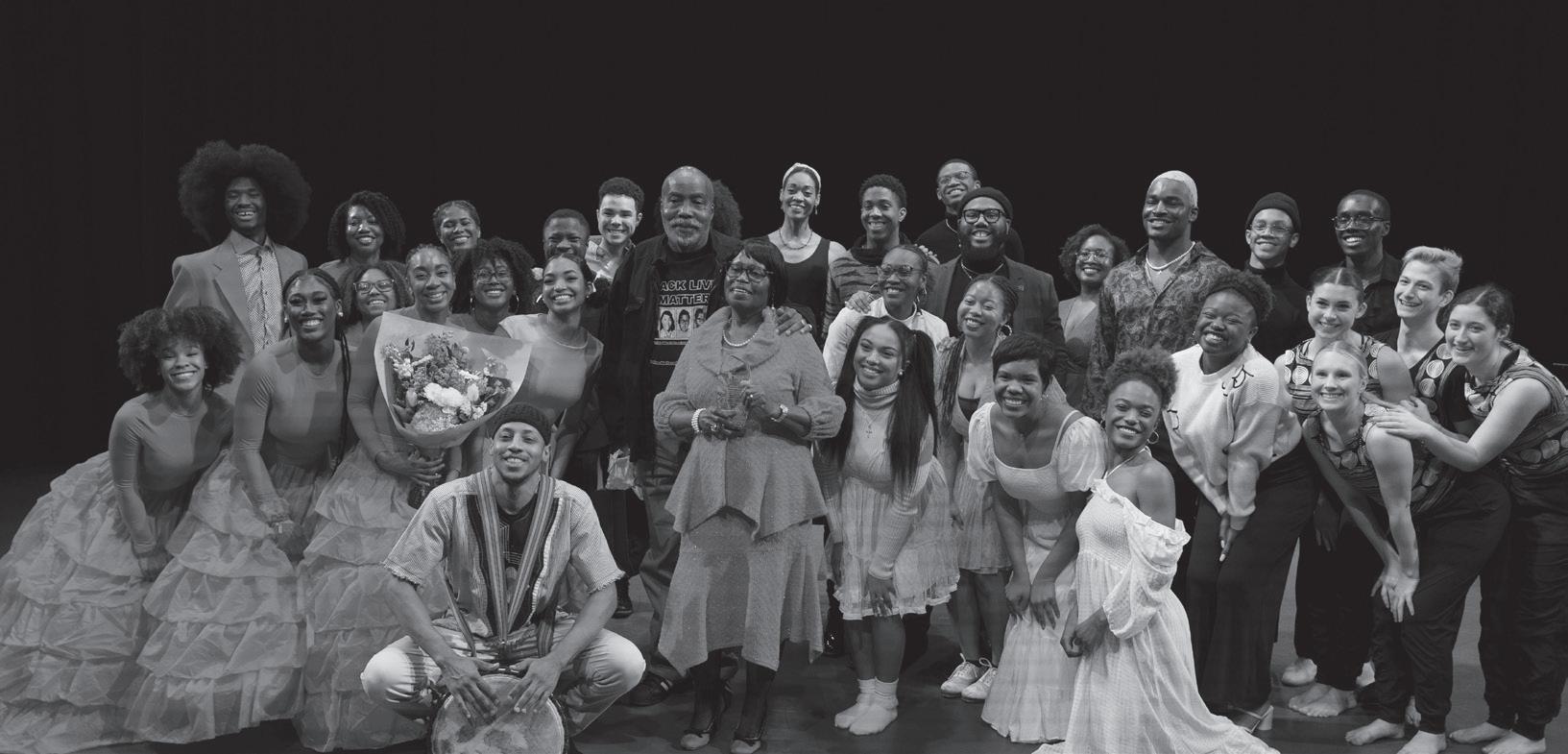
To start the evening off, U-M dance professor Robin Wilson cleared the space through an African derived ritual called “Libations,” where one pours water into a plant as they honor and recognize their ancestors before them.
“This libation, this pouring of water into the earth, is a way to
When we are done (Ctrl. X&V)
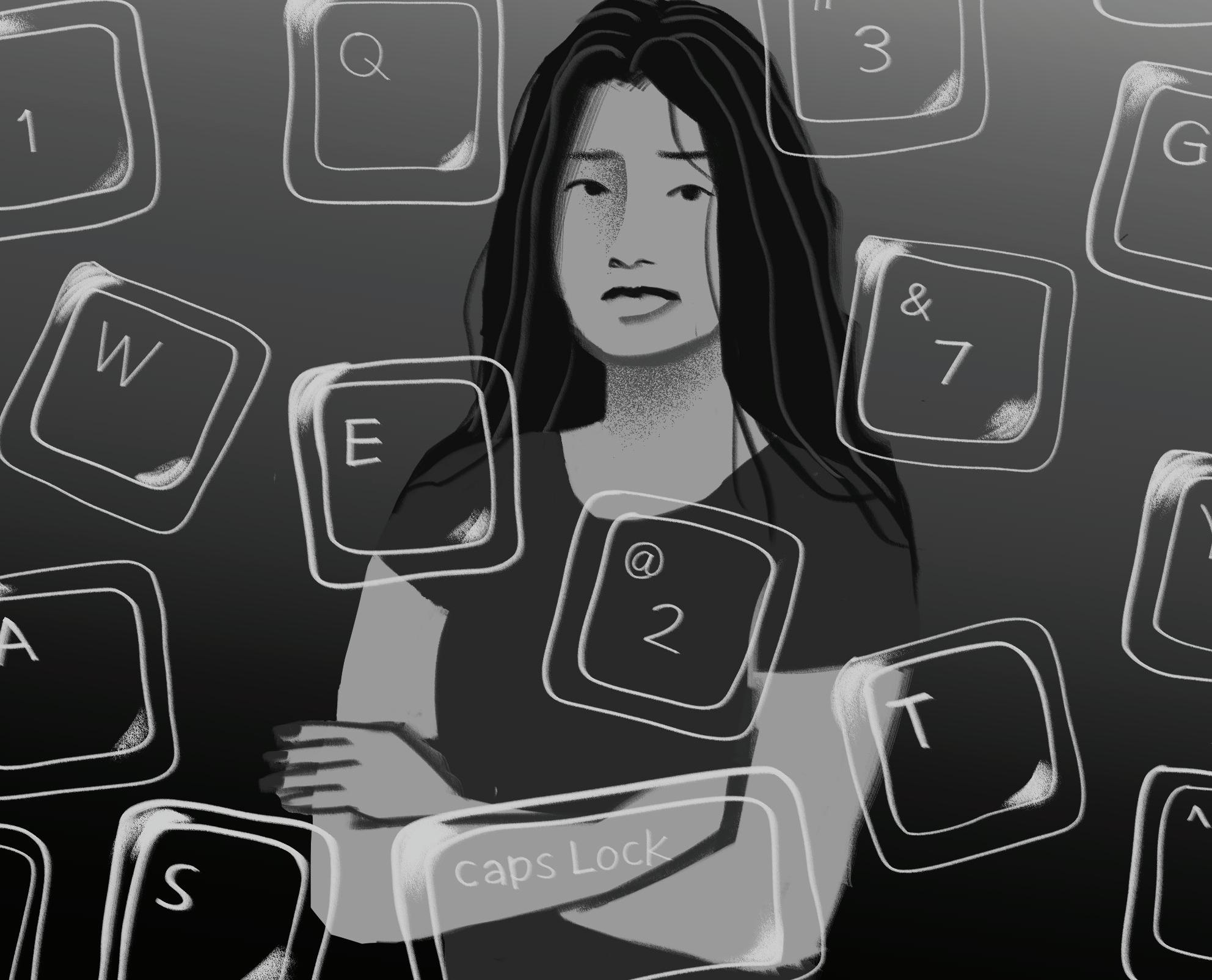
clear the space, to cool our hearts, to open our minds,” Wilson said. Throughout the libations, Marwan Amen-Ra played the drums and audience members called out the names of lash dewanoved ones who have passed. All to the sound of a resounding Asé.
Following the “For the Five” dance tribute, I performed a poem entitled “A Poem for Sarah.” This poem was dedicated to the young Sarah Collins and all the other former Black girls in the room who were forced to grow up way before they should have needed to. I was incredibly grateful for this opportunity to share my words with a Civil Rights activist and survivor, and I didn’t take that opportunity lightly but I was also writing for me. I was writing for the little Black girl that I used to be who needed to hear the words “You’re Beautiful” and “I’m Sorry.” While on that stage, it felt like it was just me and Mrs. Rudolph, like we were two Black girls who understood each other.

At the culmination of the concert, the Black Scholars in Dance organization recognized Rudolph once again. Taylor, the organization’s founder, presented her with an award that said, “We honor you as a hero, whose voice was once silenced, but now was heard and inspires a whole new generation.”
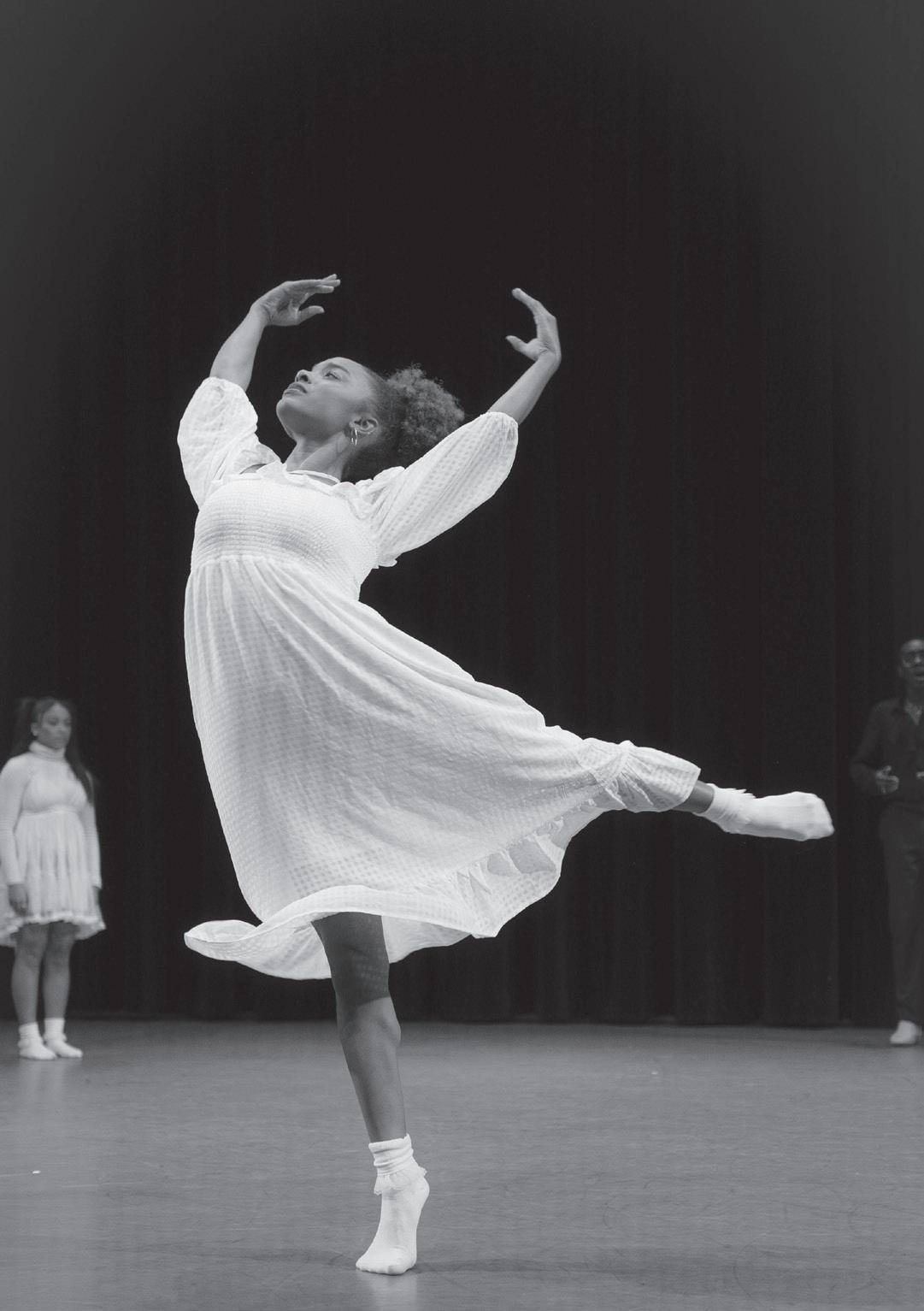
Then, Rudolph sat down for
Shut the door. The mirror beckons. Wait for it to get humid, And steep the Selves like tea, shed the sanctions, the shirts, and whisper, We’ve grown up hiding and lying, riding and flying, and drifting between living and dying.
a question and answer session. During this time, she recounted the day of the bombing and the events to follow. As an audience member myself, I hung on to her each and every word. She recalled holding a lot of anger in her heart in the years following the death of her sister and friends and the loss of her eye. She was not given any counseling before being sent back to school. She has Post Traumatic Stress Disorder and would “freak out” whenever she heard a loud noise. This PTSD would ultimately stop her from pursuing her dream of nursing school. To this day, she still has not received restitution from the state of Alabama. To make matters worse, it took 39 years for all of the men responsible for the 16th Street Baptist Church bombing to be prosecuted and held responsible for their crimes.
Yet, through her words and responses to people’s questions, it was beyond evident how important Rudolph’s faith in God was in her journey, a faith that eventually led her to forgive the men that did this to her. She spoke about how the anger she was holding felt like a sickness in her body and that she couldn’t continue holding onto that much hatred, for her own sake. It wasn’t until she was prayed over at a church service years later
that she felt free of that burden of hate and the weight of the anger in her heart. She believes that it was God’s plan for her to survive and be a testimony of what happened that morning of Sept. 15 1963.
It was also during this question and answer session that a representative of Oakland University announced that there will soon be a nursing scholarship in honor of Rudolph.
The evening was a moment in Black History that was more than needed on this campus. It truly exemplified the intersection between art and activism. I am more than honored to have been a part of it, and I am more than grateful for artivists like Brooke Taylor. I have never met someone just as committed to their art as they are to social justice and Black remembrance. She is truly a community builder if I’ve ever met one.
“I consider myself an artivist, which is an artist and an activist,” Taylor said. “I think that means that whatever I do, when I’m creating art, I strive to tell a story and to really intersect activism with my art…I wanted to do my last year at the University of Michigan right by honoring a Civil Rights Hero and survivor of a bombing that many people aren’t aware about and they definitely should be.”
When we are done cutting and pasting, a little too much soap can bathe it all away, scalding hot water will boil away mistakes, a little extra scrubbing, sting, can mask red marks with smiles.
We are larger than whole in pieces, jumping from place to place, and staring at Faults in the face.
We who are void of and saturated in talent, in masses liability grasped in our hands, maybe we’ve trapped ourselves by the fingers and the mouths.
We of yellowed skin and a temperament for Ambition; an affliction that tilts the world to slipping, missing, hating but searching for the firm grasp of My mother’s arms.
When we are done cutting and pasting, we bathe in the extremes. An exorbitant amount of shampoo and dangerously hot water will slough away any shame.
We are full of ourselves and humbled by celebrating the depth of the graves of which we’ve so gracefully created.
We of hidden lunchboxes and a spectrum of voices, this delicate dance that we’ve devised, when we’re not all made to be dancers.
When we are done cutting and pasting, a lot of everything, soap, temperature, tears, is still not enough to fill the chunks we’ve cut from flesh and a little bit of everything, is yet always a tightening leash.
When we are done cutting and pasting, we will still be hiding and lying, riding and flying, and remaining restlessly somewhere between living and dying.
So the mirror doesn’t matter, since the door shuts in the steam.
Michigan in Color Wednesday, March 8, 2023 — 7
SARAH OGUNTOMILADE & AKASH DEWAN
The Michigan Daily — michigandaily.com
MiC Senior Editor & MiC Head of Photography
ALICE HB LEE MiC Columnist
Design by Tamara Turner
AKASH DEWAN/Daily
KATE WEILAND Co-Editors in Chief QUIN ZAPOLI AND JULIAN BARNARD Editorial
EDITORIAL BOARD MEMBERS

Debates on the Diag
return to retro: Why Gen Z is
to vintage technology
MP3 players have all witnessed an explosion in market demand.
A night in isn’t always to our benefit
When marijuana is legalized, its usage skyrockets.
With dispensaries popping up on every corner and the potent smell lingering in the streets of Ann Arbor, it’s no mystery that college students are playing their part in those rising numbers. A 2021 study done by the National Institutes of Health states that 44% of college students reported using marijuana in the past year, a 6% rise since 2015. It also reports that 56% of college students said they consumed alcohol in the last year, a number that dropped from 62% in 2019.
Although legalization has made marijuana more accessible, are there other factors at play that explain why we are seeing usage numbers spike specifically on college campuses? The more important question, however, is how the increased usage affects student culture.
While on the surface social life on college campuses has returned to normal following the COVID19 pandemic, it’s impossible to ignore the lingering effects it has had on students. Even now, it’s not uncommon to see people wearing masks at social gatherings or even skipping plans in order to avoid large gatherings. Now, many students have the option of watching recorded lectures and there is much more leeway when missing class as a result of an illness. I’ll be the first to admit that getting up for class in the morning is not always an easy task, and in a post-COVID-19 era with recorded lectures, it becomes one that is easier to avoid. But all that time spent at home alone is only creating more opportunities for drug use and fewer opportunities for socialization. Outside of the classroom, rather than going out
to public places like restaurants and bars, more students are having gatherings at home with small groups. Spending more time at home only with close friends takes away from other social connections they could be making. Marijuana isn’t new; it’s always been around. For students trapped in their apartments and cut off from their peers during the lockdown, smoking or consuming marijuana was a way of passing the time.
In an interview with The Washington Post, Nora Volkow, the director of the federal government’s National Institute on Drug Abuse, said, “the pandemic seems to have actually made marijuana into an alternative to escape the monotony of isolation.” Like any potentially addictive substance, once you start it’s hard to stop. So when the lockdown ended, students’ newfound habits didn’t necessarily follow the same path. And with universities implementing more online learning platforms, it’s easier for students to stay home and succumb to their new habits.
When people think of the college social scene, whether they first think of students hanging out at a campus bar or rallying in support of their university’s sports teams, most of the scenarios have one thing in common: they entail students spending time with their friends. Alcohol is known to loosen our inhibitions and give us a higher sense of self-confidence, making it easier to connect with others. That’s why many people find that drinking with others is far more enjoyable than drinking alone. This explains why, when the pandemic took away students’ ability to interact with other people, specifically in a public setting, they became less drawn to alcohol.
Less motivated by drinking, students looked toward other ways of passing the time they were forced to spend alone. Fighting against the rising rates of anxiety and
depressive disorders corresponding to the pandemic, marijuana became a popular way of muting these symptoms and helping students to feel less lonely. However, even with COVID-19 less prevalent, the high mental illness rates and increased marijuana consumption have not been. In fact, following the pandemic, it seems that that stereotypical college experience has simply shifted from going out and getting drunk to staying home and getting high.
While the conversation around mental health and how it plagues college students is quite prominent, we rarely look at how some of our own habits contribute to these unhealthy lives. It’s easy to say that the pressures of keeping up with classwork, working part time and making future plans create stress that leads to poor mental health, but how we respond to those stressors is equally as important. Smoking marijuana allows us to go into a psychedelic state and escape our reality, which may be a short-term relief from the pressures we’re all feeling, but is not beneficial in the long run. Smoking too often causes students to confuse temporary relief from a high for a solution to their problems and, with its greater usage, is only enabling more students with what is an unhealthy coping mechanism.
While it may be seen as a good thing that students are consuming less alcohol, their new “stoner” social habits might be equally as costly. A large part of coming to college is meeting new people, which can’t be done by sitting at home. Although making those connections definitely doesn’t require drinking alcohol or even partaking in party culture, it does require students to step outside of their bedrooms — an act which, as simple as it seems, can be made hard by marijuana consumption.
TATE
“I call it my ‘off-the-grid’ time,” she tells me as she proudly holds up the device. It is not an iPhone, but rather, a flip phone. LSA sophomore Olivia Spaulding explained that she purchased the TCL flip phone in an effort to block out the distractions and anxiety provoked by her regular smartphone. “I can scroll for hours without even realizing it,” she admitted in an interview with The Daily. “This eliminates that temptation.” Spaulding is just one of the many members of Gen Z who have recently readopted the mid-1990s-era cell phones in lieu of their smartphones. Google searches for the keyword “flip phone” have increased by over 140% in the past five years, taking the internet by storm in what some are calling the “flip phone revolution.”
The flip phone is one of the few “vintage” devices that have experienced a resurgence in popularity over the past few years. For many, this return to vintage technologies is not just a reflection of an aesthetic trend, but rather a response to increasing issues of digital overstimulation. Providing relief from the overwhelming qualities of high-tech devices, “retro tech” products including digital and polaroid cameras, record players and even CD and

Bus stop blues

Quickly becoming technology’s biggest comeback kid, the flip phone has recently joined the variety of devices that have gone from obsolete to stylish overnight. Endorsed by celebrities including Camila Cabello and Dove Cameron, the flip phone movement has been applauded by various influencers in interviews announcing their conversion back to retro devices.
Receiving well over 627 million views on TikTok, the hashtag “#flipphone” has elicited a wide array of reactions from audiences. While critics of the trend claim that the revival of these devices is purely the result of nostalgia-based marketing tactics, the real reason behind the reappearance of these technologies may be more complicated. Namely, many users of the devices have attributed their switch to technology overstimulation — a problem that has become prevalent among recent generations. With an average of almost seven hours spent staring at screens per day, it is estimated that the standard American will spend the equivalent of 44 years of their life staring at screens. Research has revealed the consequences of excessive screen time to be especially harmful, with mounting diagnoses of ADHD and mental health disorders reflecting the dangers of overuse.
“There’s a growing segment of people that would like to be disconnected but still have access to the things they want,” said Ryan Reith, the program vice president of mobile devices at International Data Corporation, in an interview with CBS News. And for many, the solution to this digital dilemma can be found in these vintage technologies. Not only do they provide a chance to disconnect from social media and the other addictive components found in smartphones, but these retro devices also provide a certain physical element that more modern ones seem to lack. From the grainy exposure of polaroid and film cameras to the static background noise produced by vinyl, these older products provide a certain experience that has been lost in the digital age.
These retrospective trends provide a stark contrast to the exponential development that the tech sector has seen over the past decade. From the introduction of machine learning software such as ChatGPT to predictive social media algorithms that are strikingly accurate, the resurgence of these “old” devices is increasingly at odds with the newness of the digital age. Such rapid innovation can be overwhelming, making the increase in market demand for these nostalgic products in many ways unsurprising.
Wednesday, March 8, 2023 — 8 The Michigan Daily — michigandaily.com Stanford Lipsey Student Publications Building 420 Maynard St. Ann Arbor, MI 48109 tothedaily@michigandaily.com Edited and managed by students at the University of Michigan since 1890. SHANNON STOCKING AND
Unsigned editorials reflect the of f icial position of The Daily’s Editorial Board. All other signed articles and illustrations represent solely the views of their authors.
Page Editors
Ammar Ahmad Julian Barnard Brandon Cowit Jess D’Agostino Ben Davis Shubhum Giroti Devon Hesano Jack Kapcar Sophia Lehrbaum Olivia Mouradian Siddharth Parmar Rushabh Shah Zhane Yamin Nikhil Sharma Lindsey Spencer Evan Stern Anna
Jack
Alex
Read more at MichiganDaily.com Opinion
Trupiano
Tumpowsky
Yee Quin Zapoli JULIA VERKLAN AND ZOE STORER Managing Editors
TÉA SANTORO Opinion Columnist
The
making a return
MOYER Opinion Columnist
Design by Edith Hanlon
Design by Evelyne Lee
Read more at MichiganDaily.com
No,
Ihave a confession. I’m currently writing this article at 10:32 a.m., roughly an hour and a half before it is due. I and other serial procrastinators are aware that this vice is preventable, but it’s largely out of our hands.
Popular “to-do” list platforms such as Google Calendar, Notion and Monday.com try to outcompete each other for the best innovations in organizational features and gadgets. Ultimately, these services are spectacularly underwhelming at fighting procrastination because they hinge on the assumption that routine procrastinators have the foresight to schedule and triage tasks properly. The premise that physical bullet points or reminders of deadlines will motivate serial procrastinators lacks a deeper understanding of procrastination, which is, at its core, about aversion and delaying responsibility.
Experts in the field of psychology define procrastination as the “voluntary delay of some important task that we intend to do, despite knowing that we’ll suffer as a result.”
The frontal lobe of our brains, the primary decision-making hub for the guilt, anxiety and stress that accompany the act of procrastination, is exceptional at perpetuating a feedback loop that takes us into -crastinus, the Latin phrase for “of tomorrow” and the basis of procrastination’s etymology.
Throughout the development of various psychological and philosophical schools of thought, procrastination has toggled between an act of being unable to manage time and an act of unregulated emotions. When the all-toofamiliar (and procrastinationinviting) 11:59:59 p.m. deadline notification makes its way to the top of your Canvas feed, perhaps a mixture of the two ensues in addition to the development of bad habits. In a landmark study during the late ’90s, researchers
Head empty
began to piece together that a positive correlation between plagiarism, dishonesty and selfratings of procrastination exists, for example.
However, in 2023 procrastination should no longer be considered a failure of self-regulation. New technological tools have ushered in a new mindset — particularly among young adults — that fundamentally alters the ways college students can finagle tasks. Now, we have ChatGPT for essays, Chegg instead of office hours, Amazon next-day shipping for gift giving, Venmo to exchange or deposit money and more.
In other words, our responsibilities don’t have to be our responsibilities anymore because the option to pawn them off to a growing number (a swath, even) of apps and websites exists. In fact, the same type of phenomena still persists in the workplace, during group projects and in any kind of collaborative setting: If you avoid carrying your weight long enough, someone else will pick up your slack.

The discourse surrounding digitization, automation and all the other -ation buzzwords that describe the ease at which other people, goods or services can accomplish our tasks has always fixated on the potential loss of jobs. Since entire countries that were previously reliant on human labor to assemble cars, package foods and ship products now experience new records of unemployment, it makes sense that focus has never been placed on the unfortunate side effects of these trends for college students.
But, it is truly a travesty that serial procrastinators like myself no longer recognize our habit of procrastination in the moment. The safety net offered by technology is simply too enticing; not only can ChatGPT do my homework, but such automation can, in fact, take the pain away from writing my essays and crossing my Punnett squares altogether. Students are now more comfortable with waiting until the nth hour because, deep down, their work
isn’t really theirs anymore. Remedies advertised to “fix” procrastination are obsolete because the negative feelings that should accompany the act of avoiding tasks are no longer present. Elaborate reward systems such as the popular Forest app, which plants a real tree for time spent studying, are less effective because they reward others for our effort, not us — this does little to forge long term habits, no matter how altruistic. Sure, I can try journaling, starting my work earlier or letting a Pomodoro clock run, but common productivity strategies fail to recognize that in the end I no longer have to finish what I start — my apps will. The ideal environment for serial procrastinators to find their productivity groove is made more unattainable amid the constant advertisement of products and services that seek to deplete the little motivation we have left.
In an interview with The Michigan Daily, Dr. Anis Ismail, a physician and postdoctoral research fellow at the University of Michigan discussed these habits. “When I was in medical school, what kept me motivated to hit the books was that I’d be ultimately responsible for others’ wellbeing in the future,” Ismail said. “If there comes a time when a significant aspect of the physician’s role is now on technology to diagnose and treat patients, I don’t think future medical students will be as compelled to make sure they have a breadth of medical knowledge memorized.”
The only foreseeable cure to serial procrastination in the Western world is completely disengaging from our devices. But, that’s neither practical nor efficient. We serial procrastinators are sort of in a catch-22. When the next “guaranteed” and “sciencebased” productivity software or service appears on the market, it will only contribute to the narrative that procrastination can be fixed with buttons and clicks — the things that got us into this mess to begin with!
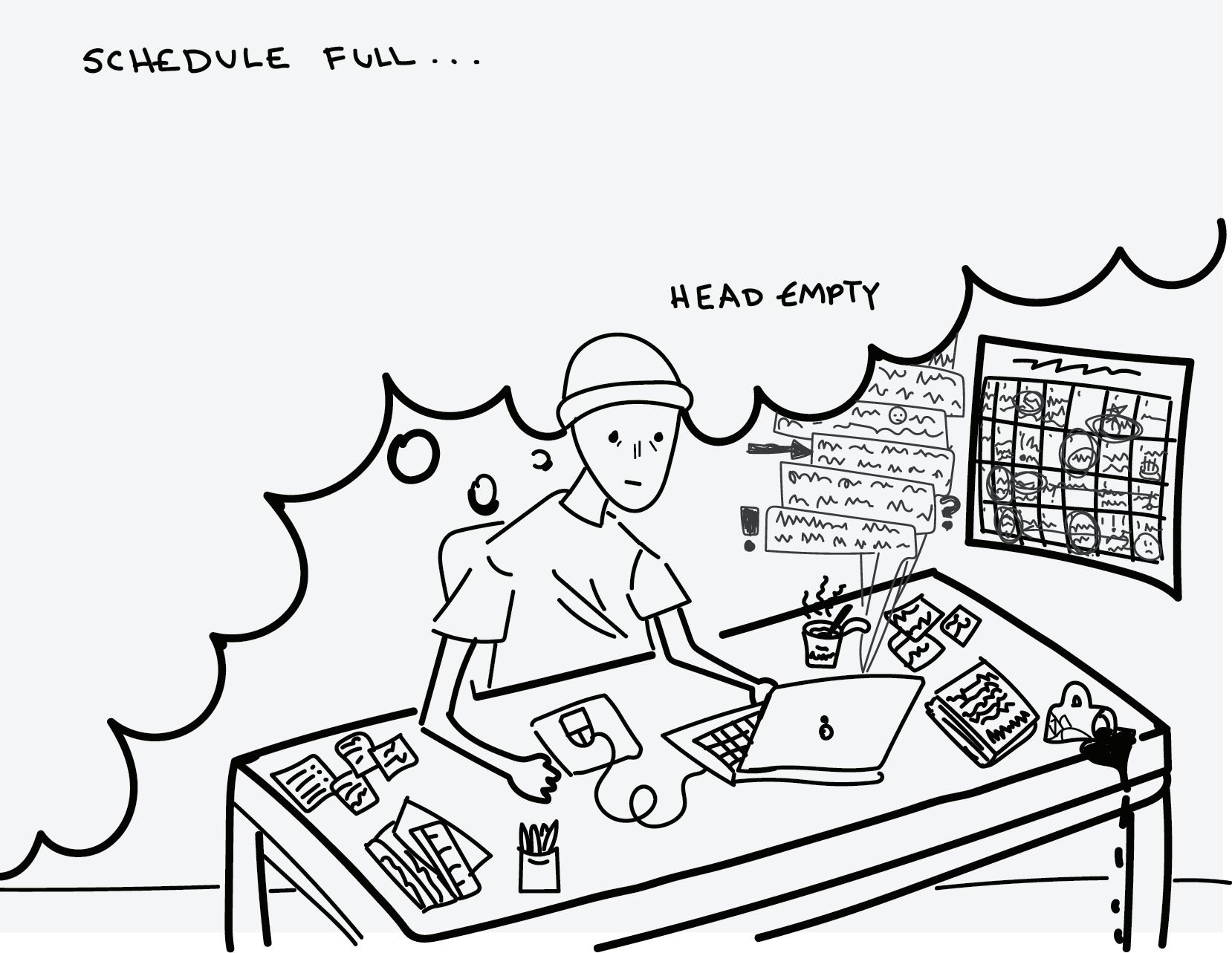
Formula 1 drivers are often heralded as the 20 best drivers in the world. This is wrong. The 20 best drivers don’t drive F1 cars. They aren’t behind the wheel of an LMP1 hypercar snarling down the back straight of Le Mans, nor are they rounding the banked turns of Daytona or Indianapolis in Target-branded stock cars. In fact, most aren’t behind a wheel at all. Money has blocked the paths of many talented drivers for decades now, and the effects aren’t just felt by those who lost out on a seat. Racing fans suffer as well. The financial obstacles that a driver must navigate in order to get a seat in any championship are more like dams: Only a few with enough money trickle through into the next championship. It starts in karting, F1’s equivalent to little league, where European parents can spend exorbitant amounts of money to have their child race each weekend. Although the amount can be lessened by sponsorships, racers and their families can pay up to $2 million to compete over a multi-year period. And, if they intend to keep racing, the money will only have to continue flowing: $500,000 in Formula 4, $1 million in Formula 3 and $3 million in Formula 2 are the conservative estimates. It’s no wonder many of the sponsorless drivers are sardonically referred to as “pay drivers.”
Former F1 driver Nicholas Latifi is a quintessential example of this type of driver; he has a $1.2 million yearly contract, but his father’s net worth is estimated to be $2 billion, and his father paid his former team $30 million a year while Latifi was driving in order to keep him in the car. He finished third to last in the 2020 and 2022 seasons among full-time drivers.
Latifi was not a competitive driver; he was only there because his family had the financial wherewithal to usher him through. This isn’t only a problem for drivers who should have been in his seat, but for those watching at home as well. It’s unenjoyable to watch drivers who aren’t talented crash expensive rocket ships into tire barriers over and over again.
It’s clear that pay drivers don’t consistently foster competitive racing. Among previous Formula 1 World Drivers’ Championship winners, many came from humble beginnings. Fernando Alonso, Jenson Button, Sebastian Vettel and Lewis Hamilton all grew up in lowerclass families. It’s not difficult
to see that racing is made better when it is between those who are genuinely talented as opposed to those who are simply rich, but we often forget the quality of racing that we miss out on under the current, pay-to-drive system.
Furthermore, these paywalls aren’t restricted to the highest levels of racing, nor are they only found across the pond. The recent WeatherTechsponsored Rolex 24, a multiclass 24-hour race in Daytona, Fla., featured multiple drivers with deep pockets. The only difference between the end of January’s endurance race and last year’s F1 season was that the American pay drivers appeared to drive well.
George Kurtz, owner and CEO of cybersecurity behemoth Crowdstrike, was one of four drivers to pilot their hypercar in a valiant but heartbreaking second-place effort. Cooper MacNeil, son of WeatherTech CEO David MacNeil, won his class’s race. Upon closer inspection, however, we see that both drivers put in the slowest lap times among their teammates; neither pay driver was anywhere close to the times put up by other drivers in the same car. The racing these two men displayed just wasn’t as good as it could have been; it made for less competitive teams and thus a less interesting race.
The underlying problem is that the barriers are normalized. Of course, drivers and executives condemn the issue, but there’s an implied assumption that these financial obstacles are baked into the fabric of modern racing. Talking about costs in lower levels of racing, F2 CEO Bruno Michel tells racefans. net, “Costs are more or less the same that they were 20 years ago in European Formula 3. … We’ve done everything that we could over the last 15 or 20 years to keep the costs down.” While it’s tough to come to a definitive, statistical conclusion regarding cost changes over the past decades, drivers who have shoved their way through the system have spoken out about how the situation has worsened.
“If I had to start over from a working class family, it would be impossible for me to be here today.” Hamilton, a seven-time world champion, said to AS, a Spanish online newspaper covering sports, “because the other guys would have so much more money.” Hamilton, whose journey to the pinnacle of motorsport has been told many times, notably did not come from a rich family; his father worked multiple jobs to fund his early karting career before he earned sponsorships from McLaren. He is all too familiar with the financial hardships
that accompany a racing career. His voice, in direct opposition to Michel’s, paints an unfortunate picture of the dichotomy between what those in charge believe and what is actually happening behind the wheel.
It is a truth of nature that racing fast cars is expensive. Paying for damage insurance, qualified engineers, angry engines and complex aero packages is inherently a pricey endeavor. You can’t just go around handing out Porsche 911s to any kid with fast times at their local go-kart track, and it would be incredibly difficult to permanently separate these costs from driving in any championship. One possible answer could be assisting individual drivers in earning sponsorships that would pay for (or at least alleviate the cost of) seats. As of now, only the greatest karting drivers receive enough sponsorship money to advance up the racing ladder. Providing funds and sponsorship education to a larger group of racers would do a lot to combat this issue in both the immediate and long term.

This seemingly utopian, meritocratic dream where only the best drivers get seats is a reality in other realms, like esports, which provides a lower-cost alternative to in-person racing. The recent F1 Esports season was extremely competitive, with one round featuring a gap of only 0.2 seconds between the first and last driver. The races were therefore more enjoyable to watch. The driving was tight, each win felt earned and there were no races where one driver fled the pack and ended up even seconds away from the drivers behind them.
And, there are indications that esports ability can translate to a real car. In the recent Race of Champions, an amateur event between former and current racing celebrities in the snow-laden forests of northern Sweden, F1 esports champion Lucas Blakeley faced off against two-time F1 champion Mika Häkkinen and current F1 Alfa Romeo driver Valterri Bottas. He beat them both. Blakeley’s talent is evident, and yet the 21-year-old will likely never see an F3 seat, much less F2 or F1. It’s time for that to change.
Educational and financial resources can and should be provided to those who have been left out of the paddock for decades. The perpetuity of these financial barriers creates an exclusivity that worsens over time, and, in chipping away at these barriers’ strength, car racing of all disciplines won’t only be more equitable for future generations’ drivers. It will be better to watch.
Opinion
The Michigan Daily — michigandaily.com 9 — Wednesday, March 8, 2023
there isn’t a cure to serial procrastination
Ask a child to draw a car, and certainly they will draw it green
MOSES NELAPUDI Opinion Columnist
LUCAS SZENTGYORGYI Opinion Columnist
Design by Hailey Kim
Design by Cassidy Brimer
Design by Arunika Shee
‘Finding the positives in a game of failure’: Amanda Chidester’s road to the Olympics and beyond
TASMIA JAMIL Daily Sports Writer
With anticipation mounting each second and the cheers from the bullpen echoing through an empty stadium at the 2020 Tokyo Olympics, Amanda Chidester stepped up to the batter’s box for Team USA in a close 1-0 game — fulfilling a lifelong dream. But that moment was almost taken away from her.
Following the 2019 selection trials, Chidester eagerly waited for a glance at the initial USA softball roster for the Olympics. After seven years of competing for Team USA and spending a lifetime in softball, it all came down to this moment. It was Chidester’s first opportunity to participate in the Olympics.
But when the roster was released in January 2019, Chidester couldn’t find her name on it.
Although Chidester was a twotime All-American with multiple Women’s World Championships and World Cup experiences, her exemplary resume wasn’t enough. From playing at high-level international tournaments to being placed on the Elite Team — Team USA’s “B” team — in 2018 before being cut, her career took an abrupt turn.
For Chidester, it was a wake-up call.
“It was the most soul-crushing thing,” Chidester told The Daily. “But (it was) the best thing that could have ever happened to my life. … It made me take ownership and make changes.”
As someone who has embraced the challenge throughout her career, Chidester turned her rejection into motivation. With one last tryout left before the roster was finalized, she started an introspective journey to understand what was lacking in her performance and implement changes to her routine. All to ultimately secure a spot on the roster.
And as Michigan’s new assistant coach this season, Chidester is making self-reflection and the ability to respond in the midst of adversity — the mindset that eventually made her an Olympic silver medalist — a norm for the Wolverines.
***
Growing up in Michigan with two older brothers who were both athletes, sports became an integral part of Chidester’s upbringing.
Whether it was playing tee ball, catching with her dad, or playing basketball in the backyard with her brothers, Chidester was always ready for competition.
“From the time that she was two, she was playing tee ball and she would be just so fired up,” Amanda’s dad, Brian Chidester, told The Daily. “Other kids were just running around the field, but she was just fired up about competing and winning.”
That passion only grew with time, transforming Amanda into a tri-sport athlete — playing softball, volleyball and basketball — through high school and receiving All-State honors in each. In her sophomore year, though, Amanda made softball her priority and became the face of the program.
After leading Cabrini High School to back-to-back Michigan state championships with her offensive talents and team-first mentality, Amanda’s approach to the game didn’t change. She found room for improvement every time she stepped on the field.
“(Amanda) never liked to lose, ” Cabrini High School’s former softball coach Debbie Norman told The Daily. “Even in drills, she’d always go ‘Give me one more!’. She made
it special for her teammates but she never put herself higher than them.”
Amanda’s internal drive to refine her skills only developed further under the mentorship of former Michigan coach Carol Hutchins during Amanda’s time as a Wolverine. ***
When Amanda first arrived at Michigan in 2009, she was one of just three freshmen on the team. But immediately, she found herself in the starting lineup.
In her first game, Amanda started as the designated player — a position where experience is preferred. And experience was abundant on that softball team, but Amanda never let her own lack of it hinder her performance. She ended her first weekend with six RBIs and validated Hutchins’ trust in her.
Although Amanda’s performance highlighted her offensive abilities, it was a glimpse into her versatility. With aggressive base running and influencing the game as a catcher at times, that made her potential apparent to Hutchins and the rest of the coaching staff.
“(Amanda) was a perfect prolific offensive player and she was going to bring that power to the lineup every single day,” Michigan coach Bonnie Tholl said. “But she was also a jack of all trades.”
To start her freshman season, Amanda fit into the designated player and catcher with ease. Soon though, she was forced to extend her comfort zone to play outfielder, infielder, second baseman, third baseman, and eventually first baseman by her senior year.
“(Hutchins) pushed me past limits that I knew existed inside of me,” Amanda said. “She helped me realize there’s always more in the tank and made me want to get more out of myself.”
While each position on the field has its array of skill sets with minimal overlap, Hutchins believed Amanda had the ability to enhance each of those skills — a difficult task for any player. But Amanda didn’t shy away from the challenge.
“(Amanda’s) goal was learn something and to get better pitch to pitch,” former Michigan left-hander Nikki Cortis told The Daily. “She could see the positives in a game of failure.”
Although she didn’t instantly shine at each role she was tasked to play, as a competitor and a team player her entire career, Amanda was willing to take risks and learn from mistakes to adapt as the Wolverines needed.
“She played every position with maturity and never complained,” Cortis said. “And when she messed up, you couldn’t be mad at her because you knew she was constantly trying to get better.”
Whether it was at the plate with her hitting or fielding with her physicality, Amanda wanted to be the best version of herself to help her teammates and impact winning.
“(Amanda) was destined for greatness and excitement,” Tholl said. “She brought that energy, that excitement every single day.”
Despite ending her collegiate career with only one College World Series appearance in 2009, Amanda was part of a more than .700 winning percentage team throughout her four years, tallying 200 RBIs and just twenty-six fielding errors across 231 games. She left an imprint on the program as her offensive metrics rank high among school history records. And the program left an indelible mark on Amanda. Her passion
for the game, combined with Hutchins’ guidance, evolved her perception of softball, making her an ultimate competitor.
“I approached the game with big goals, big dreams,” Amanda said. “I always set high goals for myself and show up every single day to give it my all.”
But as she left Michigan, those goals didn’t disappear. Instead, they broadened and she set her sight on the Olympics. That road to the Olympics, however, was full of obstacles.
Following her time as a Wolverine, Amanda participated in multiple international tournaments for Team USA before taking an assistant coach position at Duke in 2016 — a job with more stability — while continuing her training.
However, that stability didn’t seem to matter when the International Olympics Committee voted to bring back softball for the 2020 Tokyo Games. Amanda couldn’t keep herself away from the opportunity to compete.
All of Amanda’s professional career was geared toward the Olympics, but in 2019, it all began to unravel when she was cut from the team.
“A pretty devastating moment in our whole family’s life,” Brian said. “We’ve just never expected that to happen but (for her) there was no pity party.”
With one more tryout and a final chance to earn her spot, Amanda knew she had to be at her best to stand out among the rest, and that would require some adjustments.
After communicating with her coaches, including Oklahoma’s Patty Gasso and Team USA’s coach for the summer of 2018, four-time Olympian Laura Berg, Amanda identified what the adjustments would entail. She began to focus on her conditioning — incorporating rigorous workout routines, changing her diet, and prioritizing her mental health to enhance her performance.
As Amanda continued her training, she decided to join the Chicago Bandits in National Pro Fastpitch (NPF) to test herself at the professional level. In her first and only season in the NPF, she won the NPF Player of the Year award and compiled a .374 hitting average, leading the Bandits to a championship series.
Amanda’s training and resilience through the process paid off when she qualified for the Olympics in October 2019. But soon the COVID-19 pandemic presented another hurdle. The uncertainty and fear that the games might be canceled overwhelmed the thoughts of many Olympic athletes, including Amanda. Being a late addition to the team, the rescheduling of the games to 2021 was a relief for Amanda, allowing her to develop some chemistry before heading into play.
“She turned her ‘failure’ into fuel for her to be able to succeed,” Team USA outfielder Hailey McClenney told The Daily. “She played her best when she needed to play her best.”
In the opening round of the Olympics, Amanda made her presence evident in the pressurefilled moments. Down 1-0 in extra innings against Australia, Amanda stepped into the batter’s box with poise, roping a ground ball to the outfield for a walk-off, tworun single to secure Team USA’s spot in the finals.
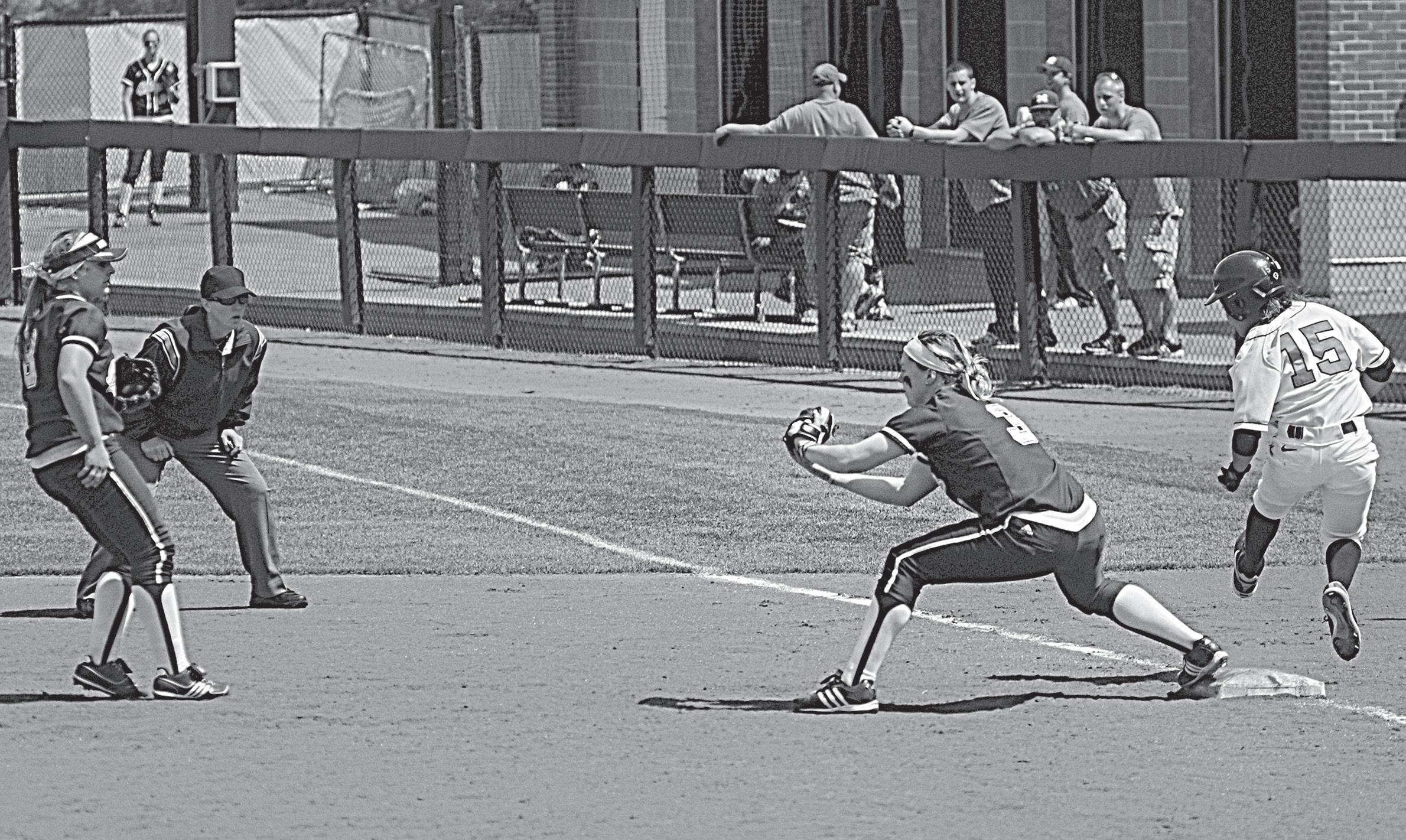
Read more at MichiganDaily.com
ZACH EDWARDS

Michigan coach Bonnie Tholl is no stranger to the Michigan softball team. And with that familiarity, Tholl understands the legacy and prowess of the program — along with the disappointment of early playoff exits in recent years.
Before the season began, Tholl proclaimed her Oklahoma City mindset — the mindset that revolves around approaching everyday with the inclination of reaching that final destination in Oklahoma City, home of the Women’s College World Series.
“There’s not much air at the top of the mountain,” Tholl said Feb. 6. “That’s why very few people get there. But that’s always what we’re shooting for and so we’re not going to make excuses for why we’re not succeeding on the field. We’re going to find a way. And if it doesn’t happen tomorrow we’re gonna work for it until it happens and we’re going to keep our standards high.”
The expectation has always been to make it to the Women’s College World Series, but the Wolverines have not matched that expectation since 2016. And it’s safe to wonder if — given the current state of the program — Tholl set the expectations too high.
Tholl has worked as assistant coach, associate head coach, recruiting coordinator and now head coach in her 29 years with Michigan — serving as associate head coach for 20 years. And while a transition to a new head coach could put the Wolverines in a rebuilding year following, Tholl has made it clear that the expectations haven’t changed. But maybe they should.

Michigan is only returning 11 of the 20 players on the roster, giving Tholl a tall task of putting together a team capable of reaching Oklahoma City. However, having served as recruiting coordinator in recent years, Tholl had a large say in bringing the new faces.
One of the biggest holes Tholl had to fill was in the circle. Michigan lost nearly all of its pitching productivity following righthander Alex Storoko’s transfer. The Wolverines also lost two of its best hitters in outfielder Kristina Burkhardt and catcher Hannah Carson.
Although the absence of these players might seem ominous, even these star players were unable to make it to Oklahoma
City in their Michigan carrers. And so far this year, many of the same issues still remain.
One persistent problem from the last few years has been production from the batter’s box.
Especially when competing against high caliber teams in pre-conference tournaments, Michigan has struggled to get its offense going. The Wolverines have tallied five home runs and conceded 16 to their opponents thus far. And while home runs aren’t everything, when severely outmatched in that category, it becomes much harder to make up ground.
Despite allowing 16 home runs this season, one bright spot has been pitching. Sophomore righthander Lauren Derkowsi and transfer junior right-hander Jessica LeBeau, have proved crucial to Michigan’s success — with much credit also going to long time assistant and pitching coach Jennifer Brundage.
In order for the Wolverines to succeed, they will need to maintain Derkowski and LeBeau’s consistency while also fixing their problems in the batter’s box that have been a constant over the past few years.
So far this season, the Wolverines have played seven ranked opponents including No. 2 UCLA and No. 3 Oklahoma State. All these games have ended in the losing column for Michigan, all due to lack of offense.
In the games the Wolverines have won, they have not been due to improvement on offense, but rather with strength on defense. Against Cal Fullerton and UCF, where both teams were similar competitively to Michigan, the Wolverines won in defensive showdowns. While there have been minor improvements in the beginning of the season, Michigan will need to improve its batting all the way down the roster in order to stand a chance against the top teams in the country and especially to make it to Oklahoma City.
“We’re going to be a team that has to take risks,” Tholl said Feb. 19. “Especially when you’re facing high caliber opponents. We need to take some risks, because maybe we’re playing opponents that had more firepower offensively, and they could hit the ball over the fence, but what we can do really well is run bases and make good on the opportunities that they gave us.”
Tholl is inadvertently revealing the flaw of her team. Teams that compete at the highest level and make the Women’s College World Series have offensive firepower. The Wolverines don’t. And if the batting does not
improve drastically, the risks they take will be the only spark their stagnant offense has. While the Wolverines may not have fared up quite as well as they wanted to so far in preconference tournaments, the most important part is to learn and improve for when it does matter. Michigan went into pre-conference games with the mindset that success and failure early on is not the end all be all.
But soon, success will become much more important. Moving into the last few preconference games, the Wolverines will have to improve upon what they’ve learned in the first few months of the Tholl era. After 20 games, splitting the win and loss column, Michigan will have to continue its improvement on the offensive end to stand a chance in the Big Ten let alone competing against the best teams in the nation.
“We knew it was going to be a growing year,” Tholl said Feb. 26. “We think we have the talent to have a successful year and so no goals have changed. We’re early in the season. We have a lot of games to play, a lot of getting better to do, and a lot of success to be had. We’re going to tighten up that defense, be consistent in the circle and find ways to manufacture runs and that’s going to continue to be our focus.”
Improvement is easier said than done. The Wolverines kept games close with opponents similar to them and beat most teams when they had more athleticism. However, consistency on offense and helping the pitchers on defense is a must if Michigan wants to compete with teams better than them.
Realistically, the Wolverines are in their first year under a new head coach and have a lineup full of new faces. With those two facts alone you would think a rebuild is more than necessary, but for Tholl, this year is more of a refuel. Knowing the legacy of the program, it begs the question: Is there really a chance for Michigan to make it to the Women’s College World Series? Or are the expectations unrealistically high?
The Wolverines will have to prove that they improve dramatically upon their early struggles or they will experience the same outcome that ended the last seven years: a regional exit. And the Oklahoma City mindset will remain just that — a mindset and not an expectation.
10 — Wednesday, March 8, 2023 The Michigan Daily — michigandaily.com Sports
Zach Edwards: Tholl sets goals high in first year, but they might be too high
SOFTBALL JEREMY WEINE/Daily
SOFTBALL FILE PHOTO/Daily
SportsMonday: Michigan
JARED GREENSPAN Daily Sports Writer
On Sunday, when Greg Gumbel reads off the names of the 68 teams that will have qualified for this year’s men’s basketball NCAA Tournament, Michigan will be waiting, its ears perked. But, barring a magical run in the Big Ten Tournament, the Wolverines won’t like what they hear — no mention of their name.
Based on their overall body of work, that’s the fate that they deserve. Because Michigan is an NCAA Tournament-caliber team without the requisite resume to land them an oh-so-coveted spot.
There is a prevailing irony here. If the Wolverines are to make the Big Dance, no one would want to play them. As they showed throughout February — after posting a 6-2 record to claw their way back into contention — they can be potent.
Junior center Hunter Dickinson is playing like an All-American again. Sophomore wing Kobe
WOMEN’S BASKETBALL
Bufkin is ascending into a potential first round pick in this year’s NBA Draft. Freshman point guard Dug McDaniel is blossoming. Freshman wing Jett Howard is healthy. There are pieces here — along with a grit and a tenacity that often seemed absent amid maddening early season struggles.
But all of that is likely to be rendered moot. See, Michigan entered the final week of the regular season needing one win — either in Champaign against Illinois or at Assembly Hall over Indiana — to place itself on solid footing for a berth regardless of its the Big Ten Tournament results. Win one of those two games, then win a game in the Big Ten Tournament, and a March Madness berth seemed likely.
This is where the distinction between an NCAA Tournament team and an NCAA Tournamentcaliber team grows most apparent. And, against Illinois and Indiana, Michigan lived up to its identity as the latter.
A team that belongs in the field holds onto a seven-point lead in
Tournament-caliber
overtime or converts on one of two opportunities to win a game at the buzzer. In Champaign, Michigan did neither, resulting in a crushing, bitter double OT loss — the sort of defeat that still gnaws at your psyche when you wake up the following morning.
One game later, the Wolverines were at it again, their season once again on the line in Bloomington.
An NCAA Tournament team holds onto an 11-point second-half lead and draws up a play at the end of
Michigan falls to Ohio State, 81-79, in dramatic offensive showdown
JACK CONLIN Daily Sports Writer
MINNEAPOLIS — It’s not easy to beat a team three times in one season.
Adjustments, changing circumstances and added motivation create different outcomes in repeat matchups, often making back-toback-to-back victories a daunting task.
But on Friday, the No. 17 Michigan women’s basketball team (22-9 overall, 12-8 Big Ten) allowed No. 14 Ohio State (24-6, 13-6) to do just that. The Wolverines fell just short, 81-79, to the Buckeyes, ending their Big Ten Tournament run after a back-and-forth battle. Despite trailing by eight points at halftime, Michigan clawed back late thanks to a strong, well-rounded offensive attack before missing a game-tying shot on the game’s final play.
“I think this was an unbelievable basketball game,” Wolverines coach Kim Barnes Arico said postgame. “Like a really great basketball game that we were in a position to win. So I think that gives our team confidence that we can compete with anybody in the country.”
From the game’s onset, it was clear that Michigan was prepared to keep pace with Ohio State’s offense. Two crisp passes put the ball in sophomore guard Jordan Hobbs’ hands, who scored a contested three. A foul was called on
the close out, Hobbs made her free throw and the Wolverines were up 4-0.
In response, the Buckeyes hit a contested 3-pointer of their own, bringing the score to 4-3 just moments into the game. The strong offensive showings on both sides in those opening moments continued on throughout the game: the two teams traded layups, deep shots and free throws to keep the margin incredibly tight throughout much of the first half, though it ended 47-39 in Ohio State’s favor.
For the Buckeyes, forward Cotie McMahon led the way — scoring 28 points to keep Ohio State on top. At times, Michigan looked outmatched on the interior, with McMahon and junior guard Rikki Harris scoring with ease on inside baskets.
“She’s a kid that goes a hundred miles an hour downhill,” Barnes Arico said of McMahon. “(She) is one of the best players in our league.”
Overall, the Buckeyes’ efficient shooting kept Michigan behind throughout most of the game. But at the other end, the Wolverines put together a strong offensive performance to keep pace up until the final moments.
In each of the first two matchups, Michigan struggled to overcome Ohio State’s suffocating full-court press. It was only logical, therefore, that the Buckeyes would employ the coverage to some extent in Friday’s matchup.
Unlike those first two matchups, though, the Wolverines looked prepared.
Michigan turned the ball over nine times, a notable decrease from their 27 giveaways in each of the first two matchups. The Wolver-
ines moved the ball well throughout, finishing with 16 assists in as clean of an offensive performance as they’ve had in recent weeks.
Leading the way for their offense was fifth-year wing Leigha Brown, who finished with 19 points. But the effort didn’t end with her: four Michigan players finished with double digits.
The Wolverines appeared up to the task of remedying the errors behind those two regular season losses. As the game looked to be getting out of hand in the third quarter, a couple of game-changing and-1 baskets from Brown and senior guard Maddie Nolan brought the game back within just one point midway through the third.
But just like in the first half, inconsistent defense made overtaking Ohio State a struggle.
The Buckeyes attacked the paint consistently in the second half, drawing fouls and challenging Michigan with physical, gritty offensive possessions.
“I think defensively we don’t want to give up 81 points a game,” Barnes Arico said. “So if we can be a little bit better on the defensive end, we’re always a work in progress.”
Then, with just over six minutes left, the Wolverines finally took the lead. Brown kicked to Nolan in the corner, who put them up 70-68.
Just as Michigan looked to gain some control, though, McMahon played spoiler. She picked off a Michigan pass with three minutes left, scoring a fast-break layup to regain the lead. Then, on the subsequent offensive possession, she drew a tough foul and hit both her free throws — putting Ohio State back on top.

The Wolverines kept fighting, however, but it wasn’t enough. With seconds remaining, Brown’s miss on a contested layup decided the game — leaving the Wolverines just short and sending them home from the Big Ten Tournament after just two games.
the regulation that doesn’t end in a rushed 3-point attempt by a center. Again, Michigan blew the lead and dialed up a bad play, resulting in a loss that — coupled with the last one — is even more excruciating, one that will sting even more. This is what Tournament-caliber teams do: They hang around, pull you in, enthrall you with their capabilities for short spurts. They get your hopes up, make you believe. And then, on a dime, they show
their other half — poor decisionmaking, careless ball-handling, porous defense, errant shots. And then, they lose.
“Tough overtime game,” Dickinson said afterwards, speaking over the joyous Senior Day festivities taking place postgame inside Assembly Hall. “It’s really tough out there. When you play so hard, make a lot of winning plays, everybody on the team just making so many winning plays, playing so hard out there. You feel like you almost deserve one of these. But you know, that’s just sometimes the way basketball goes.”
Michigan finds itself residing in Bizarro World. A March without the Wolverines feels a tad dystopian, the program having asserted itself as a second-weekend staple.
And yet the cruel reality is that Michigan shouldn’t even sniff the field — it has just three Quad 1 wins (none against top-tier opponents), three true road wins and a damning Quad 4 loss. Its metrics — ranked 39th in KenPom, 53rd in the NET — are nothing to write home about. The eye test, at this
point, becomes irrelevant.
“We’re in a great position now starting a new, second part of our season,” Michigan coach Juwan Howard maintained after Indiana. “You now have an opportunity to hold up the trophy. And it’s going to take one game at a time. We don’t look ahead. We’ll find out tonight as far as who will be our next opponent. And we’ll be prepared. We’ll be preparing to go to Chicago to compete.”
But his optimism may very well be painting too bright a picture.
With the regular season over, Michigan is out of time to render itself anything else but what it’s already shown itself to be. It does not belong in the NCAA Tournament. Will it contend next week in Chicago, maybe win a game and put a scare into one of the conference’s top teams? Sure. It probably will.
Because that is what Tournament-caliber teams do. And that’s what Michigan is.
But with March in full swing, and the regular season officially in the books, that’s not enough.
Despite rewriting the narrative, Michigan fails to find a way in third loss to Ohio State
LYS GOLDMAN Daily Sports Writer
MINNEAPOLIS — It was a completely different game.
In the No. 17 Michigan women’s basketball team’s first two matchups against No. 14 Ohio State, the Wolverines fell victim to recurring mistakes — particularly turnovers and an inability to break the full-court press. Both games progressed in similar fashion, too, with Michigan starting hot before the Buckeyes reclaimed control and never looked back.
On Friday, however, in the rivals’ third clash of the year — this time with a Big Ten Tournament semifinal appearance on the line — it wasn’t more of the same.
Michigan turned the ball over just nine times, a stark contrast to the 27 turnovers committed in each of the first two games. The Wolverines essentially negated Ohio State’s efforts in its fullcourt defense through successful press breaks — so much so that Buckeyes coach Kevin McGuff recognized the diminished effectiveness and quickly scaled down their use of the press. And Friday’s game was tight from the start, featuring no opening runs and timeout turnarounds.
“I’d say the difference was their energy,” Ohio State forward Cotie McMahon said postgame. “No team wants to lose three times in a row, let alone twice. So we knew coming into this game they’d be a whole different team just coming in, definitely taking it play by play for them.”
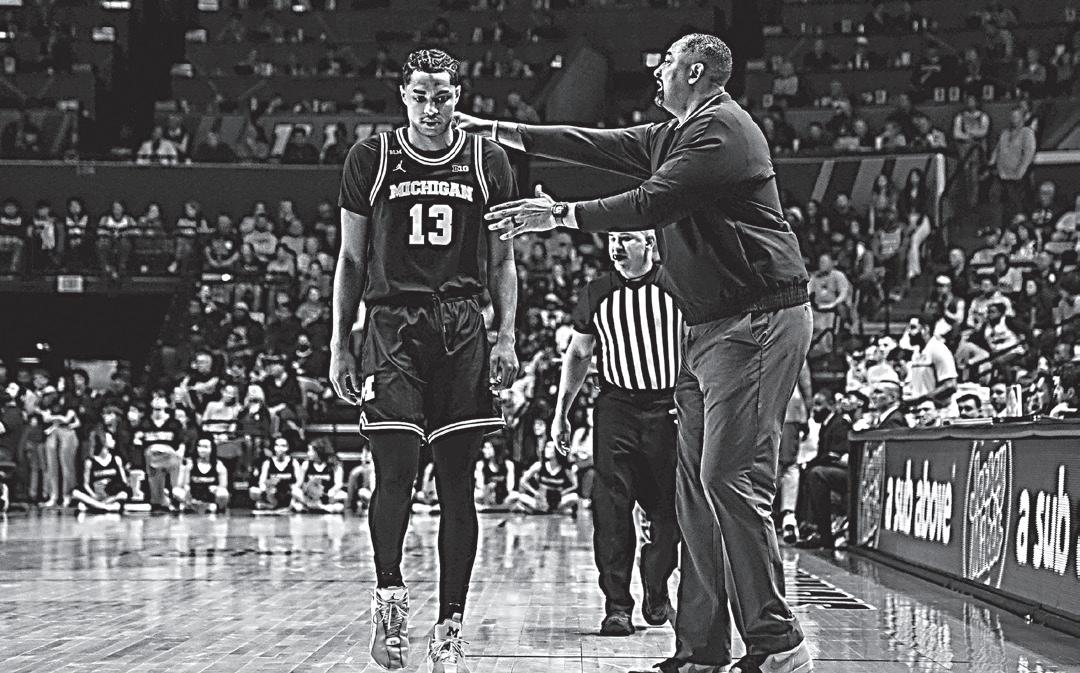
The Wolverines might’ve looked like a whole different team, and they certainly didn’t succumb to the same failures as those previous losses. They played one of their most complete games of the season, arguably their best overall performance of
this year’s conference play.
But despite all the differences, there was one big similarity between Michigan’s first two meetings with the Buckeyes and this one: the final outcome.
“Great basketball game, sorry to be on the losing end of it,”
Michigan coach Kim Barnes Arico said. “… Just really proud of our team and just the way that we battled. I thought we probably played harder than we’ve played all season long, and that’s a great sign moving into tournament time.”
The Wolverines battled through all 60 minutes, putting themselves in a position to win or tie on their final possession.
In addition to their notably low turnover numbers, they outrebounded Ohio State with 36 boards to 32, shot 43% from the field and finished with 16 total assists.
Heading into the quarterfinal contest after squeaking by Penn State on Thursday, Michigan knew it had to bring its best in order to compete.
“It’s March, right?” junior forward Elise Stuck said after beating the Nittany Lions, looking

ahead to the clash with Ohio State. “We’re going to have to come with everything we have. It’s tournament play.”
Graduate guard Emily Kiser echoed that sentiment, answering emphatically when asked to talk about the looming matchup against the Buckeyes.
“I’m pumped right now,” Kiser said Thursday. “To have them for a third time — I mean, to let a team beat you twice, to get that chance to play them a third time and a rival at that in a Big Ten Tournament setting, it’s going to be a battle tomorrow, but hopefully we just want it more.”
The Wolverines backed up those pre-game sentiments on the court. They absolutely looked like they wanted the win, and they absolutely looked like they came with everything they had. But at the end of the day, Michigan just wasn’t able to “get over the hump,” as Barnes Arico put it.
In a completely different game against the same team that beat them twice prior, Michigan still couldn’t find a way to win.
Adam Fantilli hat trick leads Michigan past Wisconsin, 7-4
It’s not often that a hockey game comes down to a duel between two skaters.
A goaltender battle, sure. But a mano-a-mano encounter like the one that took place between freshman forward Adam Fantilli and Wisconsin forward Mathieu De St. Phalle on Saturday is a rare sight.
For 58 minutes, Fantilli and De St. Phalle traded blows, recording a hat trick and three points, respectively. But thanks to a goahead goal by graduate forward Nolan Moyle, the No. 4 Michigan hockey team (22-11-3 overall, 12-10-2 Big Ten) pulled away from the Badgers (13-23, 6-18), 7-4, in the final minutes to advance to the Big Ten Tournament semifinals.
“I’m really happy with the indi-
vidual success,” Fantilli said. “But obviously, the two wins are the biggest part of the weekend, right?
We’re trying to win a championship here.”
And while Moyle’s goal gave them that second win of the weekend, Fantilli put the Wolverines in position to win in the first place.
Led by Fantilli, Michigan came out of the gates hot. Following a three-minute stack of high-quality shifts, Fantilli found sophomore forward Mackie Samoskevich on the rush. Samoskevich then fed freshman forward Rutger McGroarty cross-ice, allowing him to score on a wide-open net.
Yet De St. Phalle quickly recreated his performance that gave Michigan hell on Friday night, in the process also recreating the close game that ensued. After blocking a pass to keep the puck in the offensive zone, he located
forward Cruz Lucius with a highpressure, cross-ice assist on the power play to tie the game.
“They’re just good players,” Michigan coach Brandon Naurato said of Lucius and De St. Phalle’s line. “They possess the puck, they make plays in tight areas with no space and they can all score.”
But if he wasn’t on the ice, De St. Phalle couldn’t make that impact on the game. So starting seven seconds after De St. Phalle went to the penalty box for hooking with 6:24 left in the second period, Fantilli took over.

Within just seven minutes of game time, Fantilli scored three unanswered goals. First pinballing a power play goal off Badgers defenseman Luke La Master outside the right dot, then cleaning up a rebound and finally firing a deep wrister from the right point, he single-handedly built the Wolver-
ines a 4-1 lead.
“If you watch those goals, like even Adam’s third one, it’s a high end shot from outside the top of the circle — those shouldn’t go in,” Naurato said. “But every guy on that line won a race or a battle before that. They’re playing the right way and getting rewarded for it.”
Perhaps resting on the laurels of Fantilli’s hat trick for a moment, though, Michigan gave Wisconsin ample opportunity to badger its way back into the contest — and De St. Phalle took it. Scoring his fourth and fifth goals of the series within a five-minute span, he brought the Badgers within one entering the second intermission.
“(De St. Phalle) always found himself around the net, in the right spots,” Fantilli said. “The puck found his stick and it found the back of the net.”
Still riding the momentum that De St. Phalle provided after the break, Wisconsin soon completed the comeback. Three minutes into the third period, forward Carson Bantle finished off a rebound in front of the net to even the contest at four goals apiece. But with neither star able to break through again in the next 15 minutes, the Wolverines had to turn to someone else to break the stalemate. So they turned to Moyle.
Switching late-game onto the same line with freshman forward Frank Nazar III for the first time all year, Moyle drove to the net while Nazar sent a backhand pass in his direction. He quickly lifted the puck just over the glove of Wisconsin goaltender Jared Moe to give Michigan the lead for the last time — before it added two more goals to ice the victory.
“Maybe it’s just our team,” Naurato said. “… It’s not good for my blood pressure, but we’re finding ways to win. We just beat them by three goals, so it’s positive. I don’t care if it’s 3-0 or 7-4.”
The Michigan Daily — michigandaily.com Wednesday, March 8, 2023 — 11
Sports
is a
team. But it doesn’t deserve to make it.
SELENA SUN/Daily
WOMEN’S BASKETBALL
ICE HOCKEY
KATE HUA/Daily KATE HUA/Daily MEN’S BASKETBALL SELENA SUN/Daily
more at MichiganDaily.com
NOAH KINGSLEY Daily Sports Editor
Read
12 — Wednesday, March 8, 2023 The Michigan Daily — michigandaily.com


 photo courtesy of darrin zhou design by leyla dumke
photo courtesy of darrin zhou design by leyla dumke
Team 47 and my urge to cartwheel
Most days I don’t have time to, but when I can manage it, I like to go home for lunch. It’s a good break, not only from the competitive atmosphere of our campus, but also from all the responsibilities that hang over my head. Since I live near the Athletic Campus, I usually feel awkward walking back to my afternoon classes while lacking the athletic backpack. A stream of athletes rush against me, outfitted in their dark-blue parkas, heading to what I assume to be practice. Today, I decided to turn around and walk (drive) with them. By doing so, I got to immerse myself in my favorite team’s practice: Michigan women’s gymnastics.
My love of gymnastics is rather unfounded — I was never a gymnast nor anything related. (Though, I do have to resist the urge to cartwheel at least once an hour.) Growing up in a sports-loving family, in a sports-loving town (Ann Arbor), is most likely the root of my search for a sport to become one with. Not to mention, finding a sport to love and entirely dedicate ourselves to is

simply good for you: frequent exercise is known to boost endorphins, dopamine and serotonin — bodily mechanisms that, when activated, are proven to increase mood and ensure longevity. But, I had to find the sport I love to watch — a tedious project in itself. Football felt too brutish to watch, basketball has no risk and even swimming, my home sport, seems to lack the certain sort of shine and glamor that I had been inherently craving. It makes sense that gymnastics is the only sport that really resonates with me — it’s daring, glamorous and (even as a spectator) stressful — all I could want as a viewer. But as an athlete?
Let’s see…
Coached by Beverly Plocki, the coach with the most Big Ten titles in history — spanning any sport — makes the Michigan women’s gymnastics team not just good, but fantastically great. They are the reigning Big Ten Champions, and, as of today, are ranked fourth in the country. After becoming one of only seven teams to nab an NCAA National Championship title in 2021, Michigan women’s gymnastics seems poised to do it again — with an almost identical competition team (the notable difference
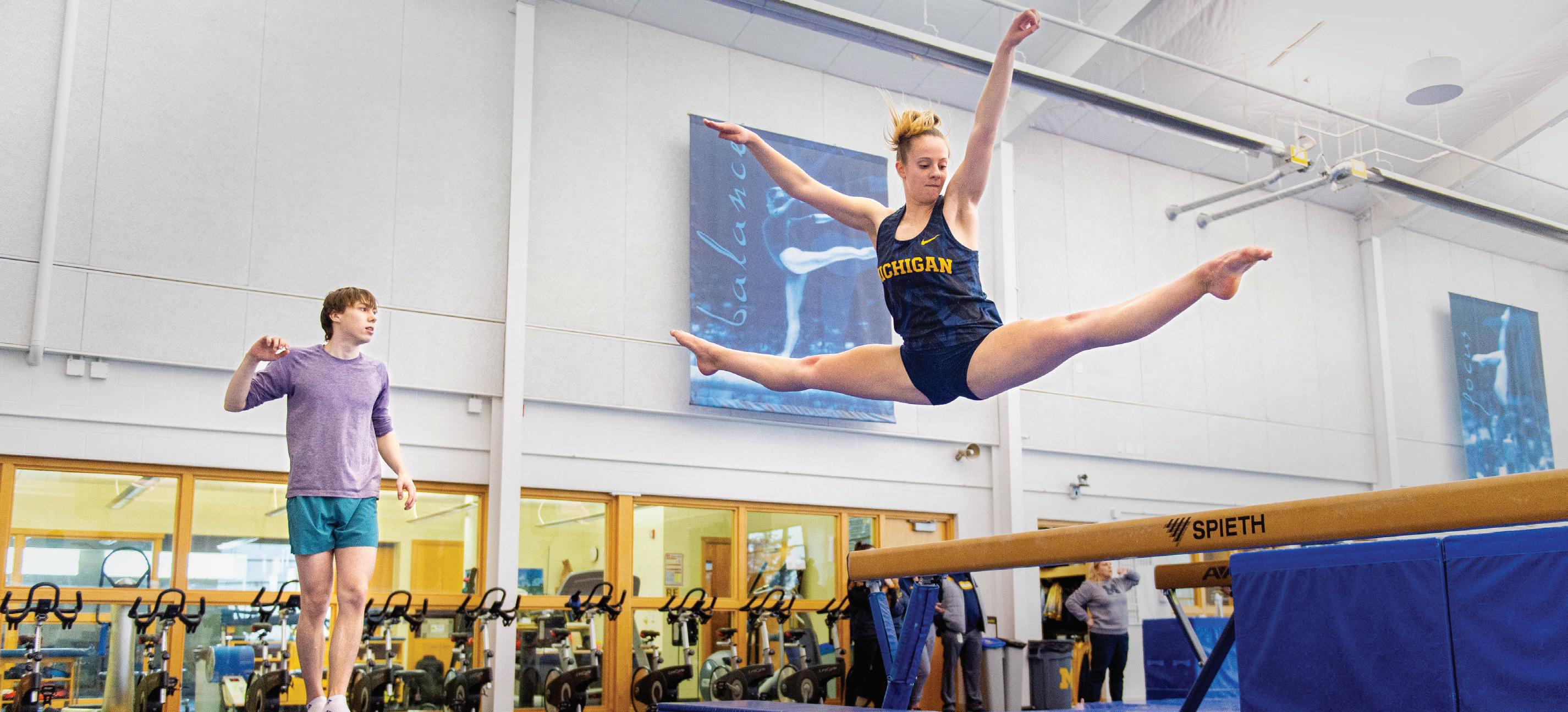
being that Abby Brenner is now at the University of Utah). The current team includes the consistent Sierra Brooks, ‘icey’ Abby Heiskell and Natalie Wojcik’s perfection, which left me wondering: How the hell am I here? And: How can I possibly not humiliate myself?
Since I am physically weaker, completely untrained and too much of a liability to flip (which my neck thanks and my heart curses), I couldn’t do much actual gymnastics. So, this immersion was basically a two-for-one: Half embarrassing myself while doing the most basic of leaps and handstands — at one point hanging motionless from the high bar — and half admiring my hard work.
Part one: Getting out there
From the moment I emailed Brooks to set this immersion up to the writing of this piece, my hands have been clammy with sweat, too much for chalk — used for its extreme moisture-wicking capacity, which enhances grip, in turn helping the gymnasts stay on apparatuses — to even help. Because I was so star-struck, I spent the first 10 minutes staring at the floor, my legs shaking with each nervous pace. My timidness was cut short by Plocki’s
booming, almost regal, voice: “you wanted to immerse yourself — get out there!” I’m pretty sure that my face turned Ohio State red — a difficult color to pull off, especially in Ann Arbor. But I did eventually get on the mat, immediately stuttering while more formally introducing myself.
Unphased by my presence and ready to start practicing, the team decided it was time to break — an end of a huddle cheer — a ritual in which I got to participate. With our feet in an aptly perfect circle (apt because they are gymnasts, obsessed with the details, such as foot placement), the team rapidly discussed what to chant, settling on: “One, two, let’s take big fives!”
Conveying their determination to win, which they did, a five team Big Ten meet.
Splitting into two groups — one at the uneven bars and one on the balance beam — practice officially commenced. I went with the beam group first, nervously stepping onto the four-inch-wide leather covered plank, laid out on the floor with mats flanking it for additional safety. I spent what seemed like forever embroiled in a mix of jealousy and complete awe, watching the gymnasts masterfully walking up and down the beam, spinning so quickly and so elegantly a tornado might as well have been summoned, doing it all as if it were second nature.
SAMMY FONTE Statement Columnist
JENNA HICKEY/Daily
2 — The Statement // Wednesday, March 8, 2023
JENNA HICKEY/Daily
Sammy Fonte watches as sophomore Ashley Lane leaps on the balance beam during the women’s gymnastics team’s practice Monday, February 20.
Maile’ana Kanewa-Hermelyn, the team’s assistant coach who specializes in the balance beam, attempted to teach me how to turn on the beam. Unsurprisingly, I couldn’t balance, and instead took steps off — costing myself a half point deduction. This seemingly-slight metric is more than enough to lose a meet, where the results often come down to hundredths of points — for example, Michigan’s 2021 national title was only won by .0175 of a point. My lack of balance was clearly a disqualifying trait, and it was a good thing none of the athletes were like me in this respect.
After fooling around for a little while on the beam, sophomore Ashley Lane, was kind enough to take me through her jumping and flipping drills. The gym is riddled with pits filled with fluffy blue pillows, providing a safe landing spot for risky attempts at new skills. Lane and I took turns jumping in. She would first demonstrate a beautiful leap, and soon after I would attempt to replicate it, never coming quite close. Lane, an ever-patient and ridiculously friendly teacher, walked me through her front and back aerial progressions, an awesomely intelligent way to learn these insane skills — a method that translates to the outside of the gym world, one of the many lessons I learned. If you simply slow down and work your way up to the difficult parts of life, for example by starting with one-handed cartwheels, you can work up and achieve goals faster and more efficiently, for example completing an aerial. I really appreciate this lent insight from these athletes. I can’t do an aerial, but I can apply their knowledge.
The limited skills I could attempt were physically challenging, so much so, that I took a sitting (and panting) break until the athletes were ready to move to the uneven bars — where my lack of strength really shined through. After coating my hands in chalk, I was allowed to jump and grab the high bar. Freshman Paige Thaxton, encouraged me to try and swing. My core engaged and my arms flexed, I piked my legs and tried. After about four seconds, I couldn’t hang on any longer because my hands burned like I

had just put my palm down on the stove.
The confines of the gym seem no different than what we all go through in the outside world — we win and lose, and we put so much love into what we do. We fall unabashedly fall and then we get up and try again.
Part two: Engaging off the mat
The other half of this immersion was much more special to me: I got the privilege to watch these athletes put in some truly incredible hard work. What stuck out to me was the self-sufficiency: They were almost coaching each other. How? I don’t know. I can barely motivate three classmates to actually finish our group project, yet somehow these athletes, my age nonetheless, were able to guide and help each other through some truly complicated gymnastics with veritable confidence.
There was a lot of beauty to the team environment. They worked as a cohesive, familial unit — dropping the individuality of the sport at the door. Helping each other not only professionally, but efficiently. Not putting themselves first, but the team — so extremely obviously. With sunlight streaming in, music
humming in the background and cheers of encouragement filling the foreground it seemed so clear, they love this school and their team enough to achieve all of their dreams.
The gym also buzzed with joy. Not only were the gymnasts falling and getting up, they all had smiles plastered to their faces. And I felt it too — the contagious joy. I mean, after doing handstands or cartwheels the smile
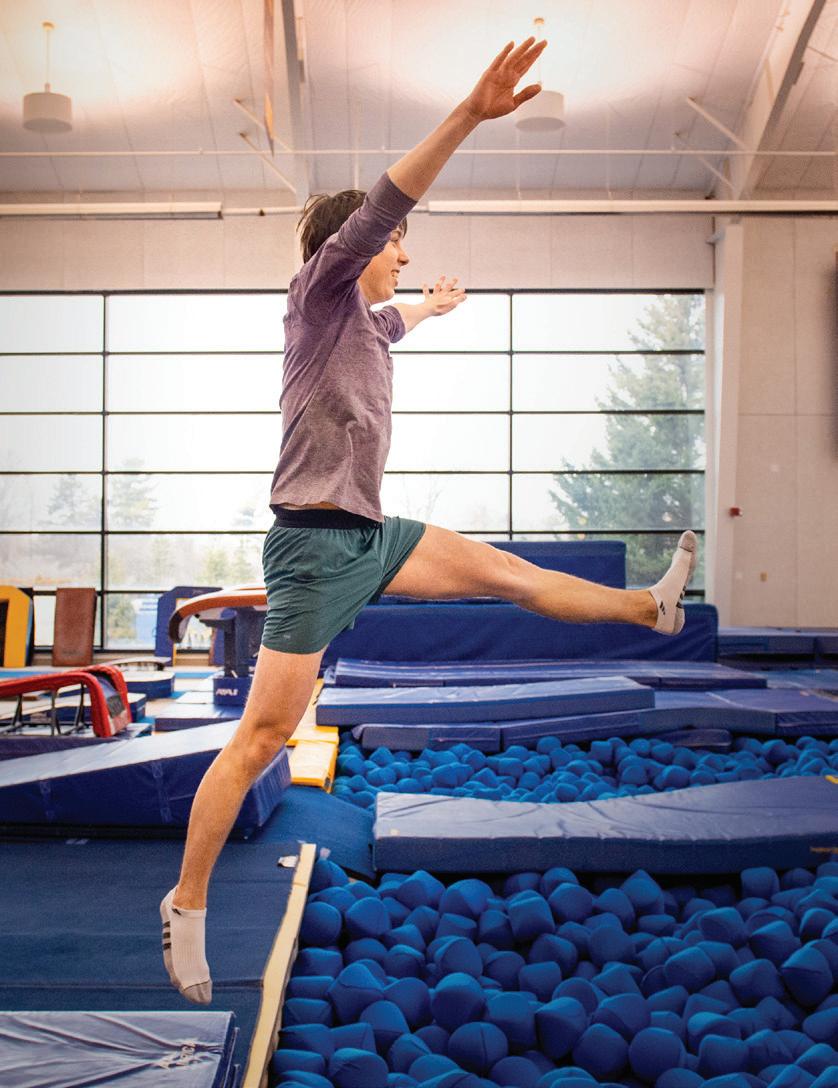
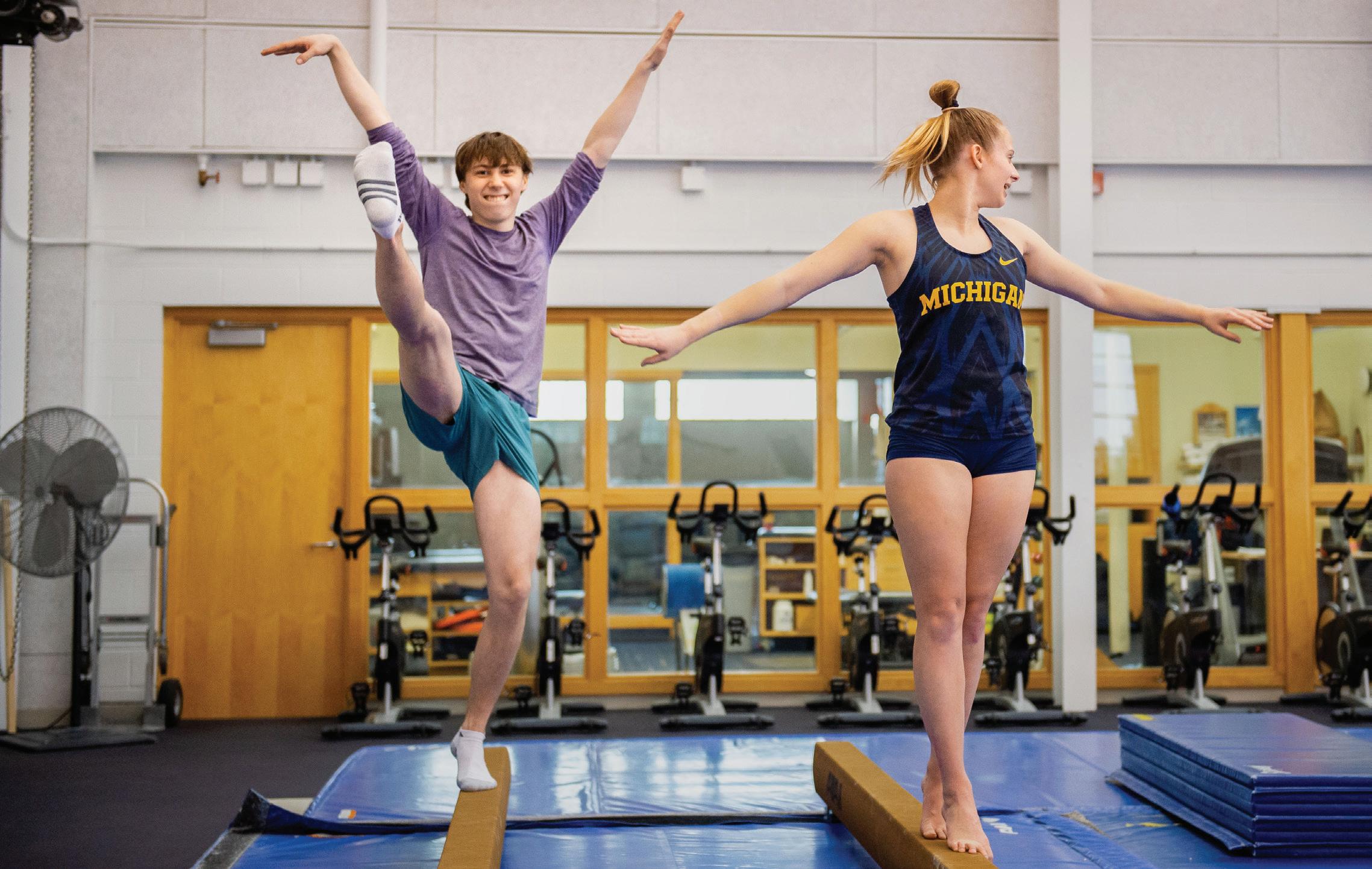
could not be wiped off my face. Joy in the hard work, the process if you will, doesn’t come often or easily, and this team has it. The gymnasts cheered after falls or perfect landings, recognizing the work, not the result. All of this seemed to be powered by love and respect — for the sport and each other. ***
Getting a whistle and a “woo-hoo” from Plocki for sim -
ply swinging on the uneven bars, while these girls do things like deltchev’s (a D-rated skill entailing a 180° into a forward salto in straddled position), is just one example of how awesome this experience and environment was. This team’s magnum opus has yet to come, despite the 2021 National Championship. And if they keep working like they are — which I have no doubt they will — their potential is limitless.
Wednesday, March 8, 2023 // The Statement — 3
JENNA HICKEY/Daily
JENNA HICKEY/Daily
JENNA HICKEY/Daily
The existential dread of self-improvement

I’m a heavy sleeper. I wake up everyday feeling like I’ve been bulldozed over, rolling around and fermenting in my consciousness, like a grain malt steeping in the darkness. Sometimes, especially recently, I’ve been carrying a sapped, dragged energy throughout my days, wishing that I’d get my life more together but never really having the spirit to do so, rolling around and wishing I’d do something.
My other Immersion Edition pitch was making ceramics, but the higher-ups decided that fixing my life was the more worthwhile pursuit. Maybe this is their way of staging an intervention. Maybe I also definitely need it. So, in all its glory, I present the Darrin-Zhou-getyour-shit-together plan, as listed:
Components of the “75 hard” program, including, per day:
- Exercising twice a day for 45 minutes, one workout being outdoors

- Reading 10 pages of a book
- Drinking one gallon of water
- Follow a diet of your choosing
- Meditating
- Taking only cold showers
- Journaling in the morning
- Scheduling “worry time”
This is essentially everything that I’ve wanted to start incorporating into my daily routines but have never gotten around to actually doing. Maybe it’s not a good idea to plunge into the deep immediately, but anything, even too much, is better than nothing at this point. So, let’s roll.
***
After a week of toil — Brussels sprouts pastas and 7 a.m. workouts — I can satisfyingly report that overall, resoundingly, the process works. I feel great! If your goal was to gain muscle and mentally feel better, I’d recommend what I’m doing now: meditation and Wim Hof breathing are clinically effective at decreasing anxiety and stress. They’re both methods based in science and they undoubtedly work. My internal shit-togetherness index is definitely higher, which is what I underwent all this misery for in the first place.
I look into the mirror at myself, and my physique has gotten noticeably better. This is what I wanted. But I don’t feel different. I
don’t feel like a better person, and I’m certainly not satisfied.
Everything’s more routine now: I wake up, journal, meditate, eat, workout, shower, Wim Hof breathe. Meditation clears my mind, the workouts satiate my body. For the first time in a while, I don’t really feel stressed and I don’t really feel anxious, which is amazing, but it’s not replaced with peace and serenity; the empty space sits as void. I feel empty.
I always thought if I just woke up earlier, went to the gym more, did all those mindfulness exercises and read more, then I’d become that person — I’d be happy — and my current state was just at tension with those actualized states of my being, like electrons out of their preferred orbits. Maybe, my thinking goes, if I just attacked those details of my life with the ferocity I know I have then I wouldn’t feel … worthless.
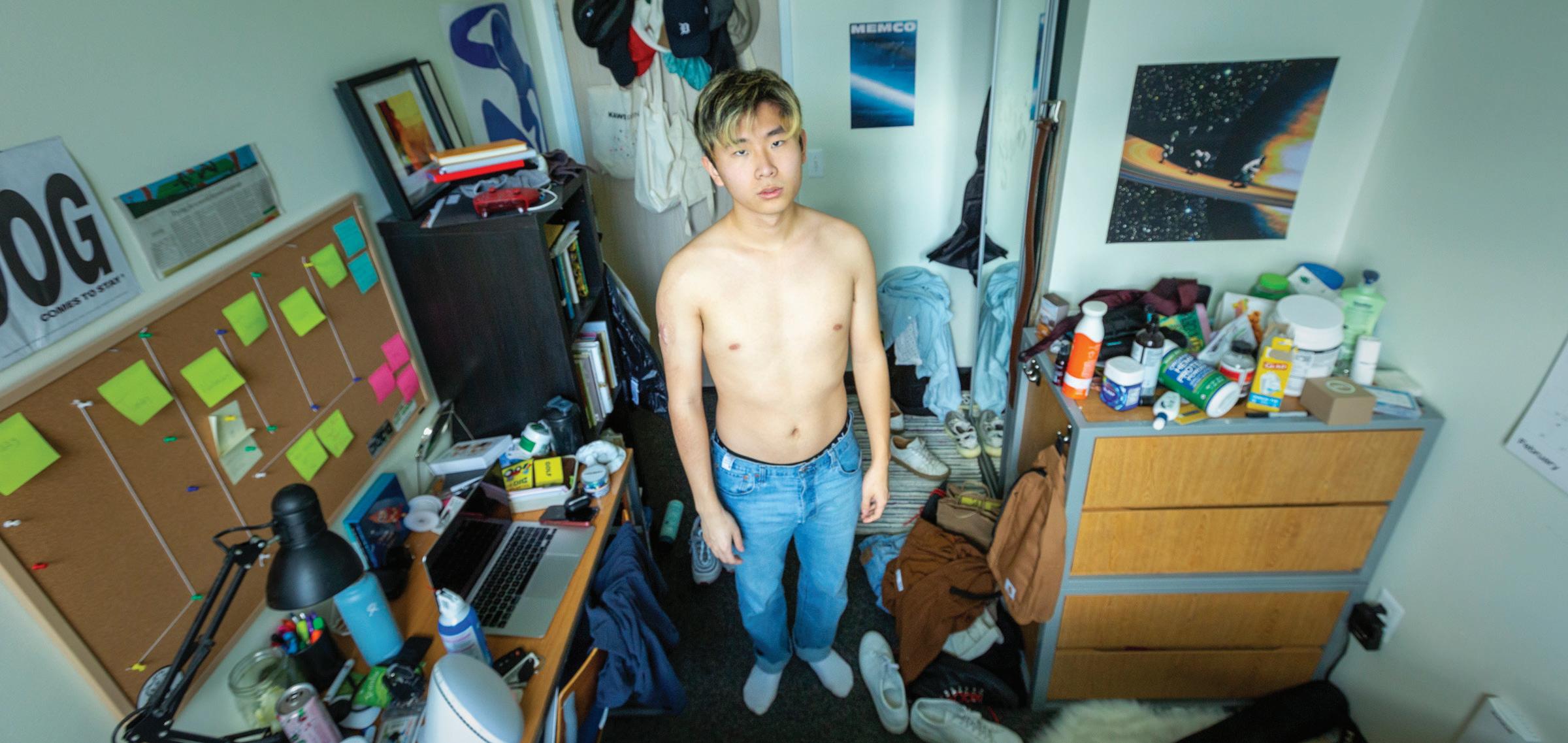
But I’m here, and I’ve done all those things, and what I’m left with is not happiness but greed. Greed for more time, for bigger muscles, even more mental clarity and even more out of every facet of my life. If I only had more. When spring comes I will be reborn, by midsum-
mer I will find love, and when the ball drops on New Year’s Eve, I will be the person I was always meant to be. Midas’ hand beckons to me: revel in this routine, in the comfort
of this siren’s call and you can feel like you’re enough.You can feel like you mean something.
I’m left with an urge for more time. I downloaded Blinkist, an app
- Wim Hof breathing
DARRIN ZHOU Statement Columnist
Photo courtesy of Darrin Zhou
4 — The Statement // Wednesday, March 8, 2023
RILEY NIEBOER/Daily
Bedroom self-portrait.
Darrin Zhou works out in the Arboretum before sunrise Saturday, February 15.
that summarizes books for you. I filled out their introduction questionnaire, and I’m told that by using their service, I can save 56 hours a month from reading books! It makes me sick. The part of my brain responsible for artistic integrity is trying to unionize, but I placate it: try it. It couldn’t hurt.
On Blinkist, I “read” the “Seven Habits of Highly Effective People” in 15 minutes. It’s a blur, but more pressingly, this method of reading saves time, and tomorrow I can listen to another Blink — the app’s name for a book summary — as a podcast while I work out. Maybe I’ll finally subscribe to one of those meal kit delivery services: I like cooking, but it’d save me time. And I always sleep too much; maybe I could try polyphasic sleep, too?
With all of this saved mental and physical energy and all this time, I work. This must be what I want. ***
Through the fervor of selfimprovement culture, I’m promised that meaning in the world is simple, with my path to enlightenment tied to its methodology and morning routines. When I have streams of passive income and fully optimized schedules, I will be fulfilled. Method books and Medium articles, then, become its scripture – “Save 20 Hours a Week By Removing These 4 Useless Things In Your Life” or “19 Rules for a Better Life (from Marcus Aurelius)” or anything that takes that sense of worthlessness away from yourself or our uncaring world and into your habits, into those things that you have control over and can change. I don’t know how true this dogma is, but I do know it’s deeply comforting to me; maybe to do otherwise is to surrender control and face the abyss.
It was Albert Camus who concluded, “One must imagine Sisyph-
be like Steve Jobs. I think everyone has wanted to be Steve Jobs or Michael Jordan at some point in their lives, but maybe we don’t consider how they’re acidic people. I mean, look at them. They’re tortured by their greatness.
Who do I want to be now?
grossed by the direct feedback that self-improvement provides and how ordered and comfortable everything seems through its lens.
us happy.” In the reinterpretation of the infamous Greek myth, Sisyphus is not crushed by the hopelessness inherent in his situation, but liberated by it. In the face of the absurd, Camus sees true freedom and happiness.

I sometimes feel that I’m being turned into a machine designed for better auto grader scores and email replies. Like Sisyphus, the roots of my discontent sprawl over the same, repetitive flowerbed: Am I injecting my life with meaning or do I accomplish nothing? Self-improvement was supposed to offer liberation, and to some extent it does, but a part of me wonders if it’s just adding fuel to the existential inferno.
Regardless, it’s Sunday, and tonight’s meditation asks me to consider my idols. As a child, I wanted to
David Foster Wallace, I think, or Mark Rothko, with their brilliant minds and tantamount works of art that they’ve blessed the world with. And, surely with their entrance into literary and artistic immortality, with their rightful place among the greats and with their achievements that their childhood selves couldn’t even begin to digest, they’re happy. They practically have to be.
They weren’t.
They struggled with what all of us, fundamentally, have to face: the human brain is in such stark contrast entropically with the rest of the world that we’re so, so desperately lonely, looking for any semblance of structure out of whatever bit of stimuli, praying for the sand grains to align when they decidedly don’t. We’re order-starved, condemned to search for clarity within a world that offers none, so when something comes along and promises that, yes, your worth can be as simple as working out this much and reading this many books, we become en-
But when the end goal of selfimprovement becomes more about those external metrics than actually increasing our well-being, without realizing it, our workouts become pushing boulders up the same hill every day, and the time spent on our habits become building blocks for an empty tombstone, and when we inevitably die, it reads: Here lies the reader. They bench pressed this many pounds. They read this many books, and spent this many hours a day working on their passions.
Overall, though, it was a positive experience. If your goal is to become your ideal self — go on more dates or make more money or break into all of your desired industries — those will be the actionable steps for you to have the requisite physical and mental clarity to be able to achieve them. You just won’t be happy. ***
It’s the last day. It’s 7 a.m. and I’m at Barton Pond, preparing to dive into the freezing water. It’s a cold plunge: the culmination of everything that I’ve immersed myself in this week.

I hop into the water and it’s
soul-suckingly cold. I’ve come to the pond with faint hopes of being reborn — maybe, when I emerge from the water, I will be that person I always wanted to be, and for a brief moment, it works. My body feels clear, and I experience a moment of profound mental clarity; everything else except for the ego washes away.
It tells me to stay in this cold forever. It beckons me deeper, and deeper, until nothing.
That thought is quickly discarded as I scamper out onto the lakeshore, wrapping a towel around my shivering body. My foot is cut from the rock bed, but I don’t notice because it’s also numb, and I don’t really feel better: just aches, and freezing, and a voice in my head saying, God, what a stupid, dumb decision.
I’m a heavy sleeper: Everyday, when I wake up, I forget who I am for a fleeting moment. I sit up and watch the rising sun cast shadows on my bedroom wall: shadows that dance to their ancient, iambic tunes, to their own cultures and histories, and for a moment I see everything, before it slowly fades as I remember my day’s work: as I remember my life. Then, I get up and I make those same Sisyphean choices anyway, minute by painful minute, second by beautiful second.
Wednesday, March 8, 2023 // The Statement — 5
Photo courtesy of Darrin Zhou
Photo courtesy of Darrin Zhou
Affirmations self-portrait.
Barton Pond cold plunge self-portrait.
How to run a half-marathon without training

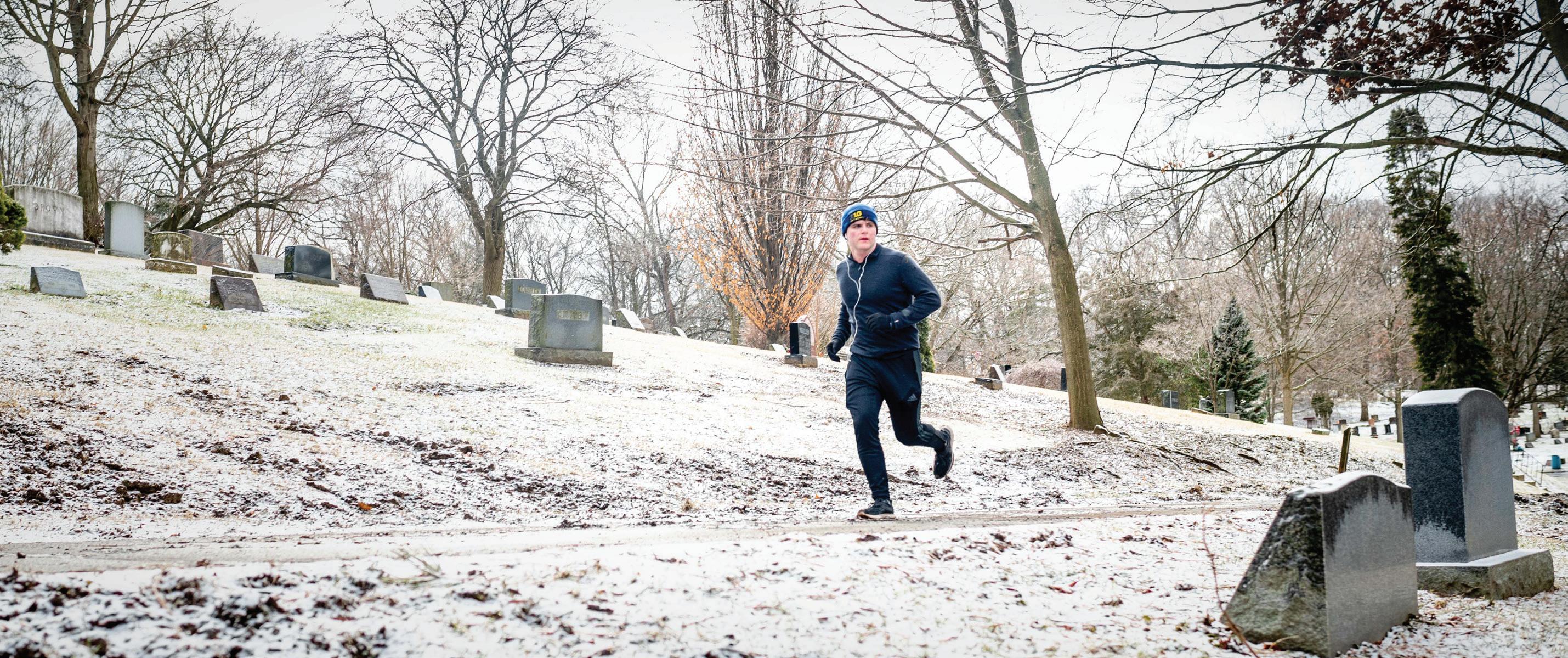
According to history, legend, or something of the sort, the first marathon was run by the ancient messenger Pheidippides who ran 26.2 miles from the battlefield of Marathon to Athens to proclaim victory over the Persians. Immediately following his pronouncement, Pheidippides collapsed to the ground and died from exhaustion, his mission complete.
I like to imagine that if he had run half that distance, he would’ve done exactly what I did — waddle to the State Street Chipotle, down a Gatorade and sit on the floor of his shower while trying not to vomit. But something tells me my journey was slightly less heroic than his.
I had always wanted to run a
marathon. When I was younger, I’d see those damn oblong 26.2 stickers on the backs of Subarus and think of the stories my dad would tell me about running around glaciers in Alaska. He was in his early 20s, “140 pounds sopping wet” and had gotten into running while living with family in Argentina. But everywhere he and my mom moved — up until he got hurt and couldn’t anymore — he ran. He ran half-marathons in Alaska and trails in Maine and New Mexico, and from his stories, I created a really magical view of what running longdistance was.
More than anything else, it seemed like a test — one of willpower, of strength, of mental fortitude. And I told myself that one day, when I was strong and capable, I would force myself through months of physical and mental training to become the type

of person who could run a marathon. But a few weeks ago, when deciding what I would immerse myself in for this edition, I decided that I might as well expedite the process. I would immerse myself in the very thing I had always wanted to do: I would run a half-marathon just to prove to myself that I could.
Now, by no way, shape or means was I actually prepared to run 13.1 miles on the snowy Friday morning I chose to do it. I had decided I was going to do so only four days beforehand. I had not trained to run long-distance, nor run more than four miles consecutively in years, nor made a route. But what I did have was a truly awe-inspiring amount of unearned confidence.
When I told my friends and anyone who would listen about my grand plan to “just run a half-marathon,”
my youthful bravado engendered three distinct types of reactions.
Most people looked me in the eyes, touched my arm delicately and said, “Charlie, this is a spectacularly bad idea.” In fact, I believe it was my club wrestling coach who, in a casually nasal and perplexed tone, said, “You won’t finish, and even if you do, you won’t be able to walk.”
The realists, having recognized that attempting to dissuade me was pointless, tried to give me practical advice. They told me to tie my shoes tight and stay off concrete town roads, and that mile nine would be where I’d want to give up.
And the last camp — composed almost exclusively of my closest friends — reassured me by saying, “You’ll be fine. Anyone can run a half-marathon” before turning back to Madden.
I chose to listen to them. They made me feel better about the run.
Now 16 hours before the run, I decided it was time to buckle down. All the online articles I read emphasized preparation, so I did just that. I turned down drinks at my roommate’s birthday party the night before and even a cigarette offered to me by a Good Samaritan. I drank three servings of Liquid IV the morning of. And I stretched for a good 20 minutes while contemplating if my light wool jacket and long johns would be enough for the low-20s temperature.
Funnily enough, my wardrobe was what I spent the most time curating. Other than my shoes, which have been my everyday shoes for the past year, I dressed like I knew what I was doing. I knew I wanted to start cold, so I wore two light layers on my upper body, paired with Adidas fleece pants and long johns on my legs. I even remembered gloves and a beanie. At 1 in the afternoon, was ready to start. Ill-advised or not, I had convinced myself that this was something I was capable of. The evidence suggested that I wasn’t — but I looked in the mirror and told myself I could do it so many times that I actually started to believe it.
I think secretly, I had chosen to run a half-marathon as my immersion experience because I wanted to make fun of myself for an attempt at a feat I felt incapable of. I assumed that I’d wheeze my way through most of the distance, and then be forced into either giving up or accepting a really ugly and embarrassing finish. I was certain that I’d just write an article mocking my arrogance and move forward with my life.
But somewhere along the line in the mental process of imagining the run, I had accidentally turned the half-marathon into more than a joke. I really wanted to do this — whether I could admit it to myself or not.
CHARLIE PAPPALARDO Statement Columnist
LILA TURNER/Daily
6 — The Statement // Wednesday, March 8, 2023
JEREMY WEINE/Daily
Read more at MichiganDaily.com
LILA TURNER/Daily
Charlie Pappalardo jogs through the Forest Hill Cemetery and Law Quad Friday, February 17.
One bi man’s journey into his comedic identity
NATE SHEEHAN Statement Correspondant
I’ve always been not so great at beginnings. Whether it’s adapting to a new place, writing a script or starting a new relationship — or as I’ve recently discovered — writing a joke, I struggle to get settled as quickly as I’d like, or immerse my audience into what I describe. But maybe this struggle with setup is a good thing. As I’ve also recently discovered, if one doesn’t know what will come next, it becomes much easier to laugh.
Over the past month, I’ve joined a stand-up comedy club at the University of Michigan, begun working on jokes and am surprised as anyone about it. I’ve enjoyed watching standup, albeit casually, since my early days in high school when a friend and aspiring comedian introduced me to 2016 John Mulaney. He was quirky and irreverent. He hated himself. He sometimes took awkwardly long steps and strode dizzyingly across the stage. One thought he might fall off the edge and he’d somehow be even more magnetic if he did. He radiated a nervous energy that was desperate for our approval, yet more than charming enough to receive it. I never thought I’d be like him. Mulaney and every comedian I saw after, usually first at this friend’s house, whether the theatrics of Gabriel Iglesias or Kevin Hart, the contrarianship of Bill Burr or Taylor Tomlinson, the storytelling of Dave Chappelle or Se-

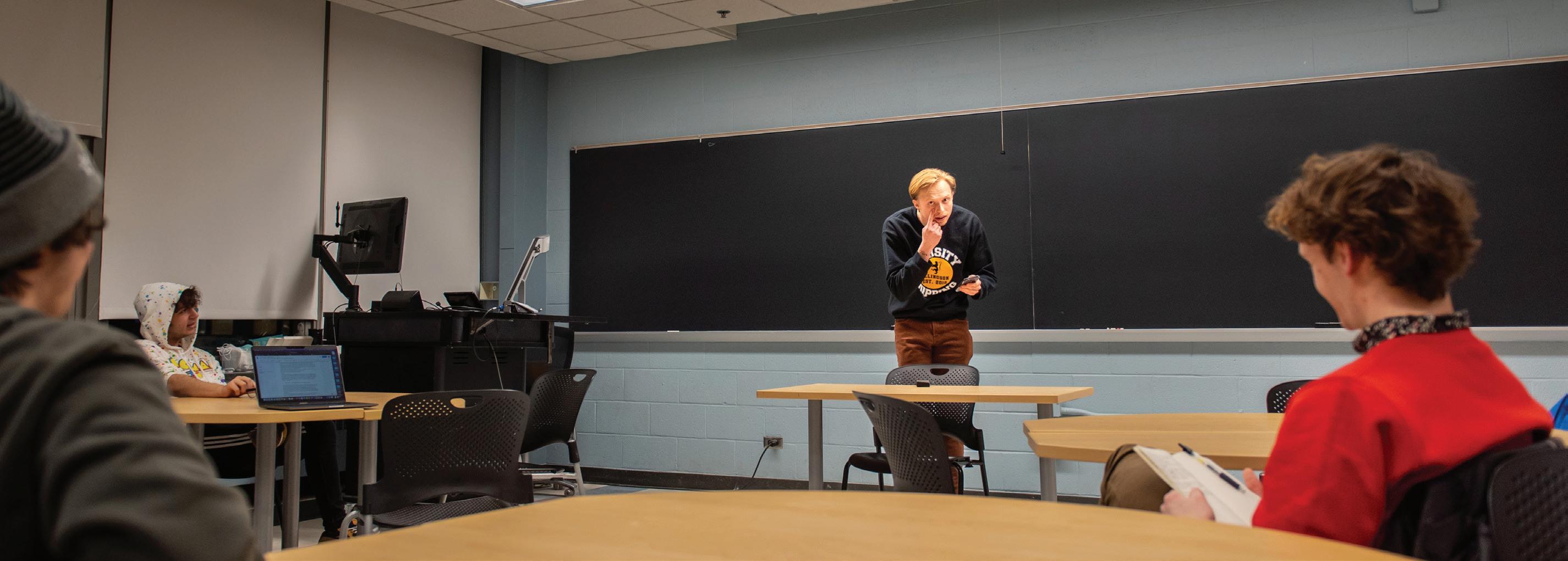
bastian Maniscolo, or the ideologies of Aziz Ansari or Jerod Carmichael, seemed so big no matter the size of their many stages. They were performers.
I’ve never thought of myself as a performer, or even an un-italicized stylization of the word. I’m pursuing an interdisciplinary theater degree in the School of Music, Theatre and Dance with an emphasis on writing and production. I hate learning lines. I’m usually terrible on the spot. My charisma depends greatly on my comfort. I can be, some might say uncharacteristically, shy. But last semester, for another Daily article on stand-up, Tyler Shotlis — the head of Amateur Hour Stand-Up — mentioned that one needs to be a bit introverted to do stand-up, as so much of the art depends on what you observe (and introverts tend to be quite good at this). This quote didn’t make the article, but it did catch my attention.
As I’ve grown older, I increasingly see my role as a creative writer to be one of an observer, both of self and others. Although I produce fiction, inspiration from the world around me has always been my closest collaborator. For the first time, I saw myself in those performers. The day I wrote my first joke, the lead I crafted was somehow both too labored and entirely missing. It was trying too hard to be clever. It was too daunting a task for the first try. Observing the notion that the United States has always been a country
of thoughts and prayers alongside FDR’s government’s decision to turn around boats of Jewish refugees from the Holocaust may be interesting, but it needed significant support to be transformed into a joke.
A semester ended and a new one began. I signed up for Tyler’s club, a space for learning stand-up comedians to practice and perform. I needed a bit more joy and playfulness in my life. I saw one of their shows late in the fall for my article. I remembered it as both so much more than and nothing but a lot of fun, a space dedicated to laughter that seemed entirely wonderful. After seeing that Amateur Hour performance, what I didn’t expect was a club so serious about laughter. Every Wednesday night, few more than 10 people would gather on the third floor of Mason Hall and perform comedy bits for each other. Through every careful listen to another’s joke, every lengthy discussion of delivery, structure and effect, I found a group of people that made being “the class clown” their craft.
In this atmosphere of earnest screwballing, I got to work. What most people ask when I mention that I’ve started doing stand-up is whether it’s nerve-racking. The answer is a resounding yes: It’s terrifying. My throat dries up. I find my gaze fixed on my phone where I’ve written my joke ideas, or toward the back wall. There are many things worse in this world to experience than telling a joke and being met with blank stares,
but when you find yourself in that awkward position, it sure doesn’t feel like it. A good stand-up must be comfortable with failure, and remember that there’s always an opportunity with the next joke to leave their audience in stitches.
To write a good joke, one needs to develop an understanding of exactly who’s telling it. Many comedians will call this their “stand-up persona” — the character they present as on stage. Often, this character will be inspired by how the come-
dian perceives themselves outside of comedy, but will likely not strictly adhere to any one source. If a comedian presented their comedy as purely as themselves, the set would likely be very boring. Not often are people’s lives that original. However, the success of a set relies on the illusion of a truthful comedian. We must buy into the persona, no matter how exaggerated, as genuine — or most of the act risks falling flat.
Wednesday, March 8, 2023 // The Statement — 7
SARAH BOEKE/Daily
more at
SARAH BOEKE/Daily
Read
MichiganDaily.com
Nate Sheehan practices material at a stand-up club meeting in Mason Hall Wednesday, February 22.




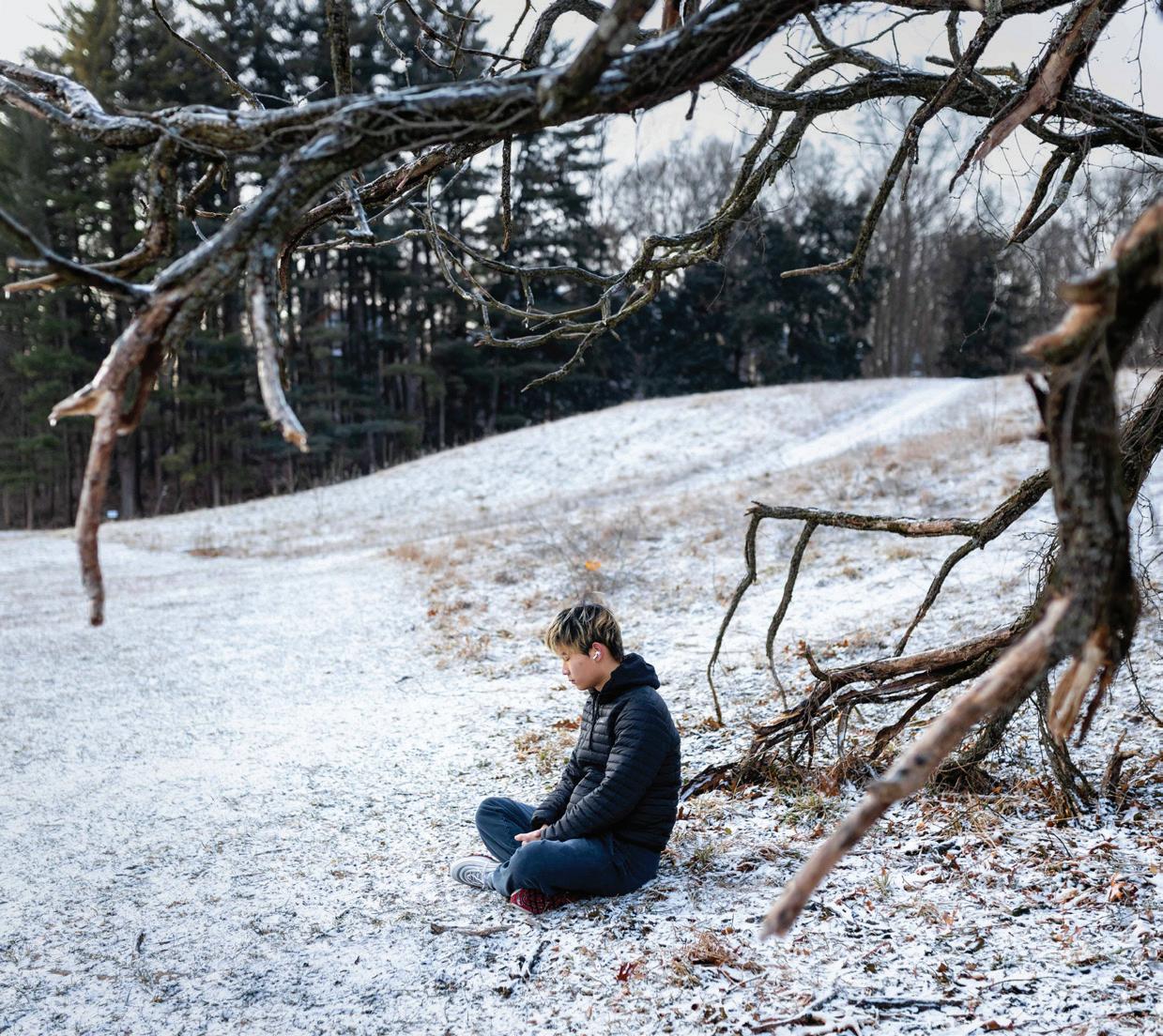
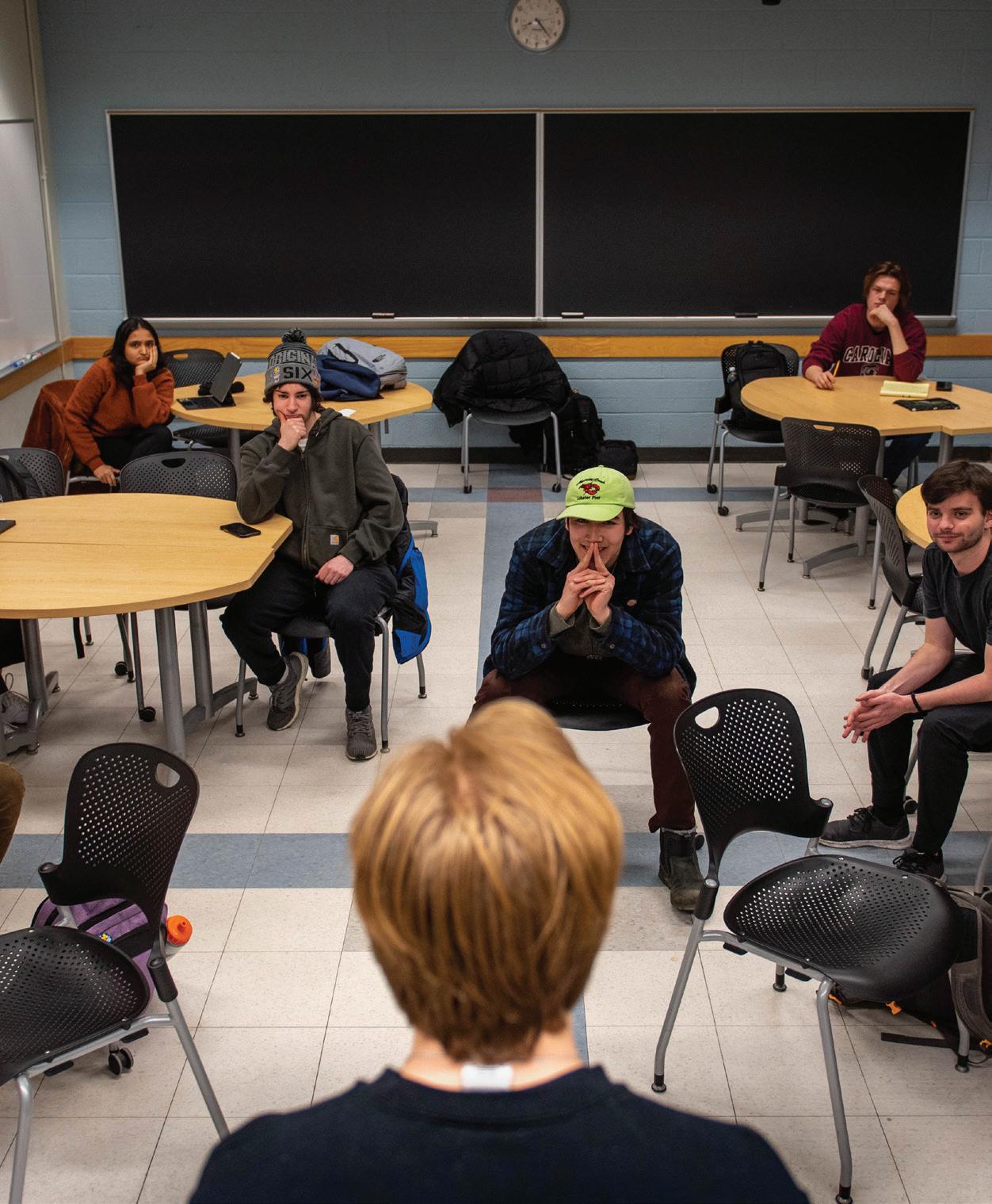


JENNA HICKEY/Daily
HICKEY/Daily
NIEBOER/Daily
JENNA HICKEY/Daily JENNA
RILEY
LILA TURNER/Daily JEREMY WEINE/Daily
SARAH BOEKE/Daily
SARAH BOEKE/Daily








 LILLIAN PEARCE Daily Arts Writer
LILLIAN PEARCE Daily Arts Writer


























 photo courtesy of darrin zhou design by leyla dumke
photo courtesy of darrin zhou design by leyla dumke






















